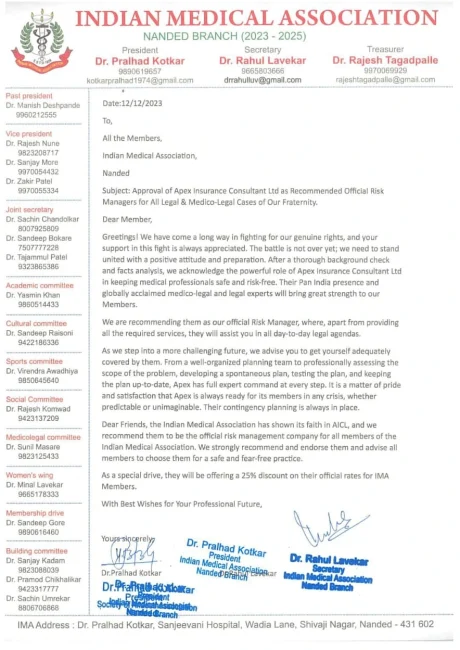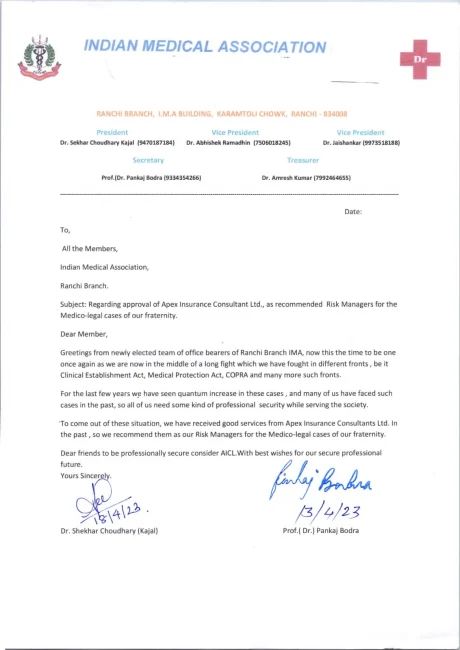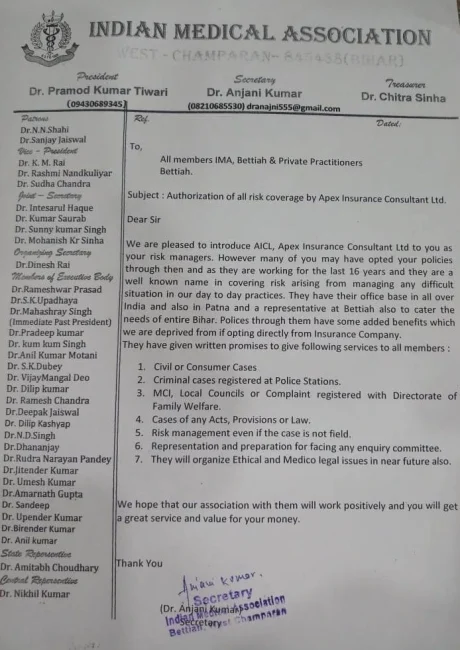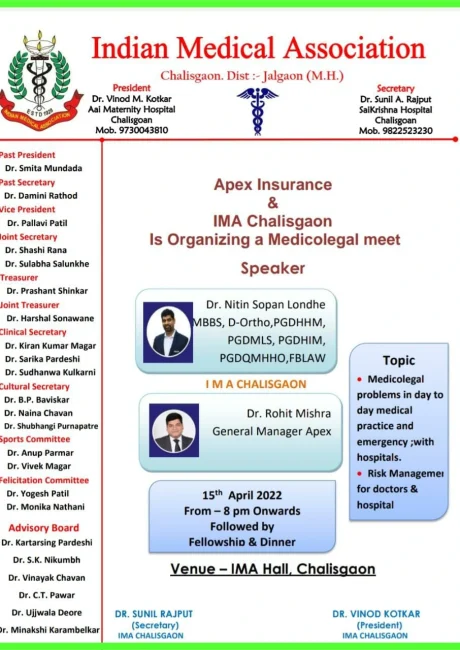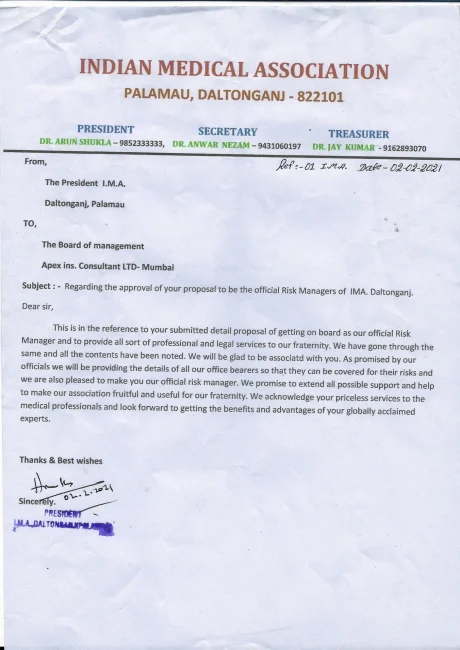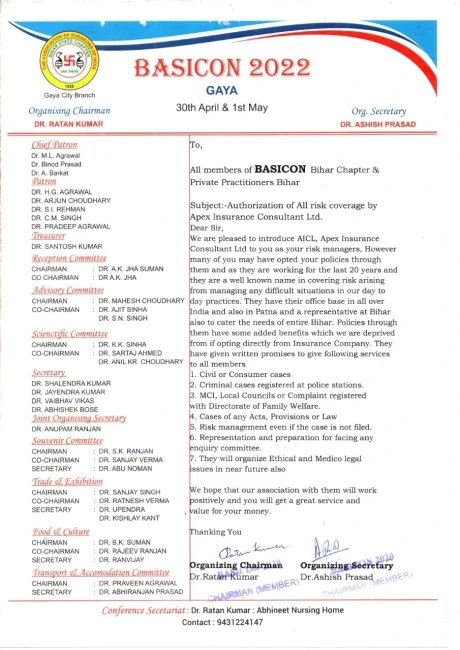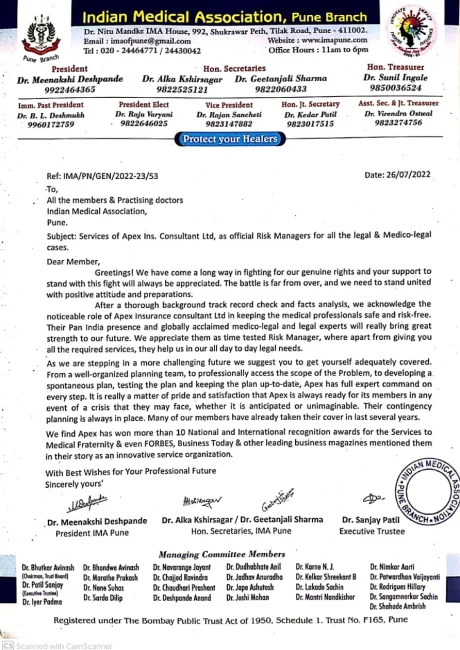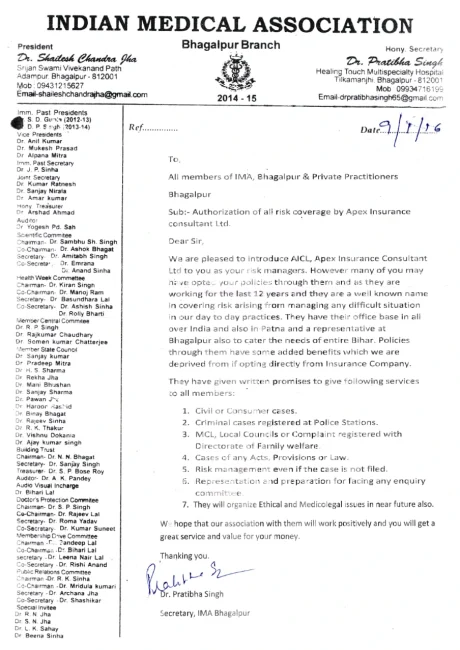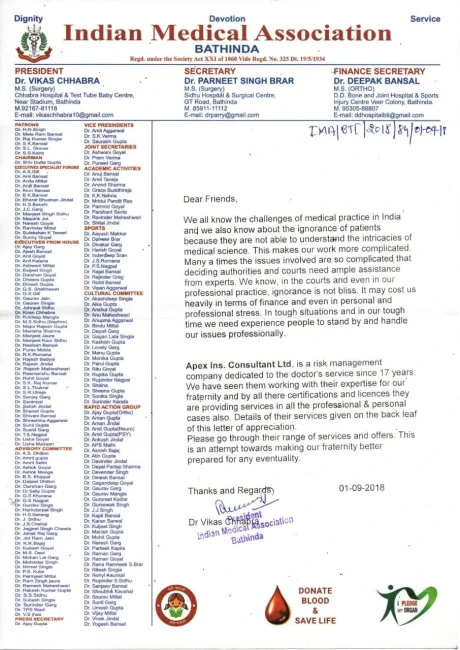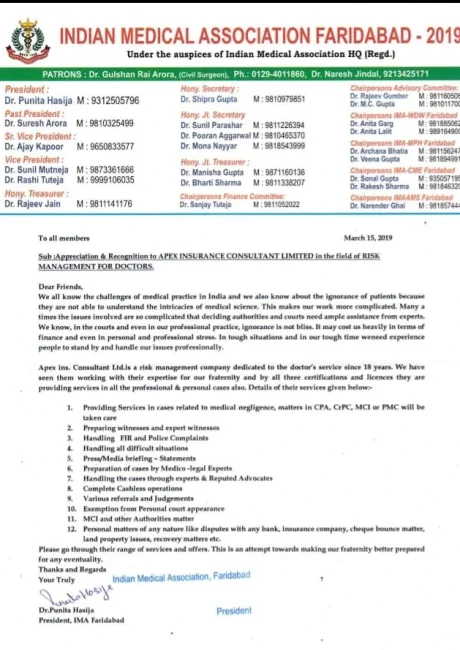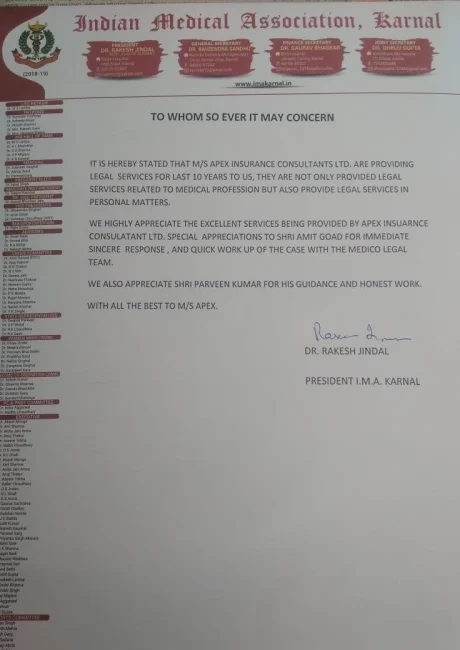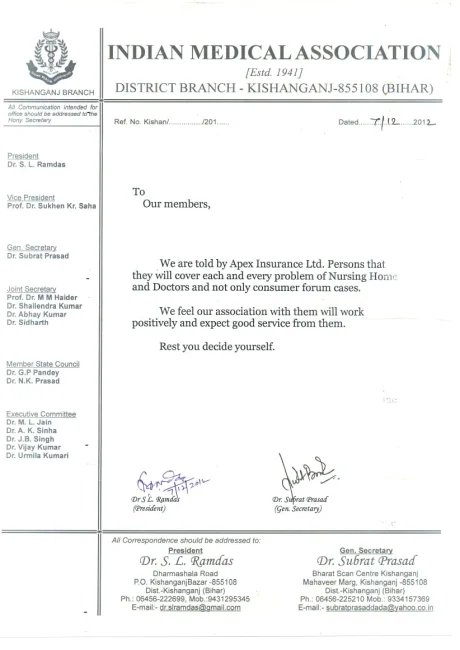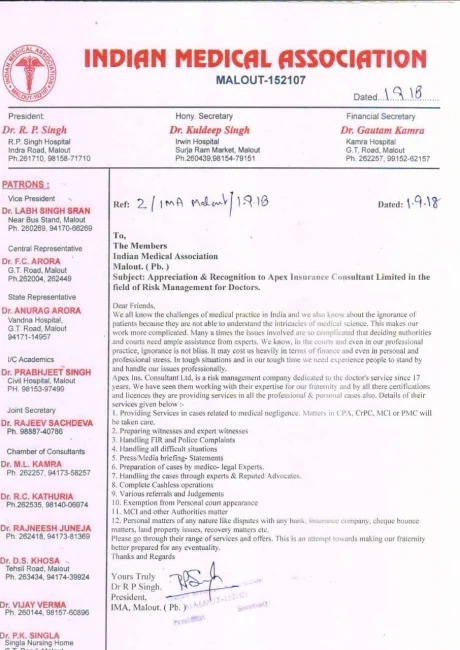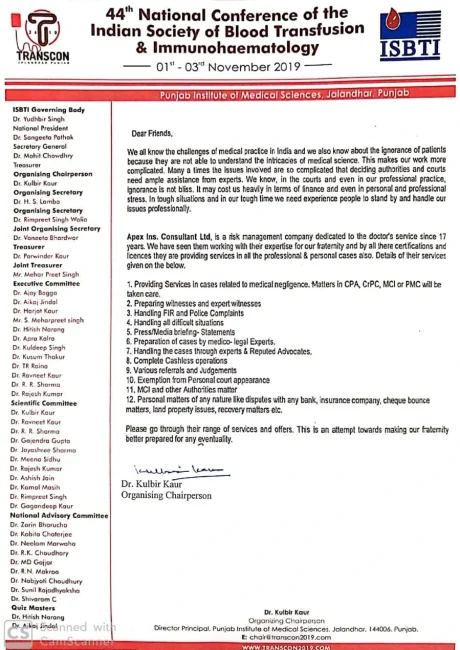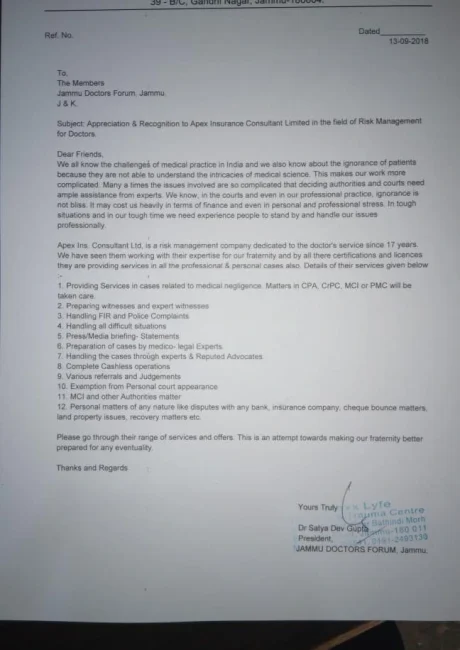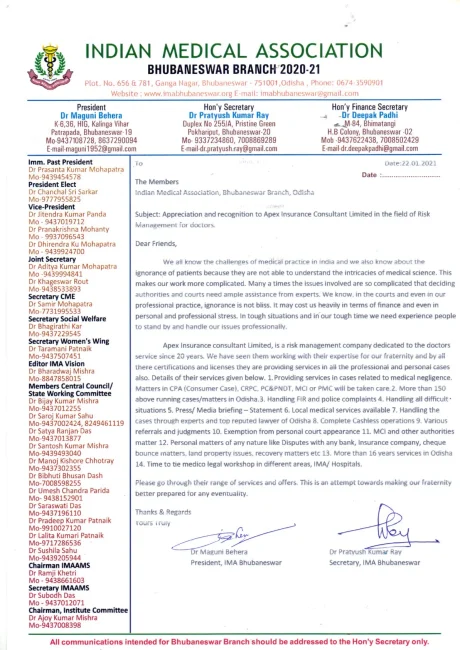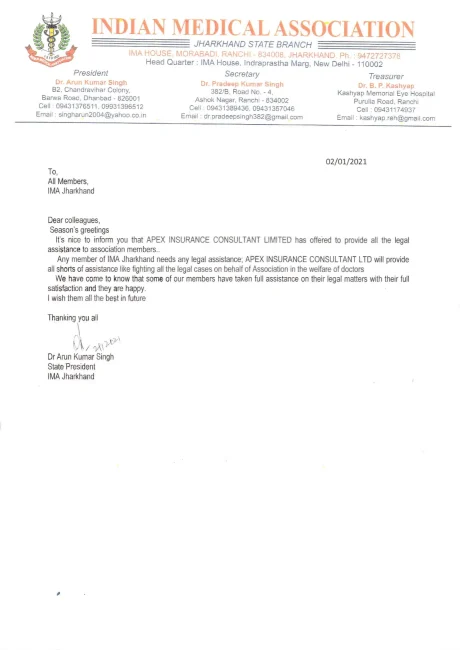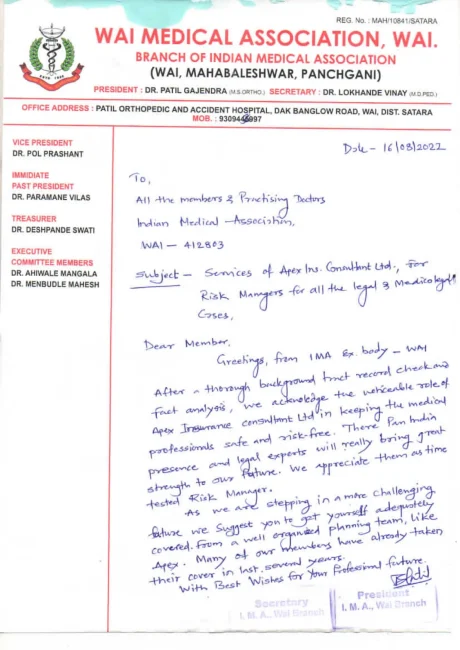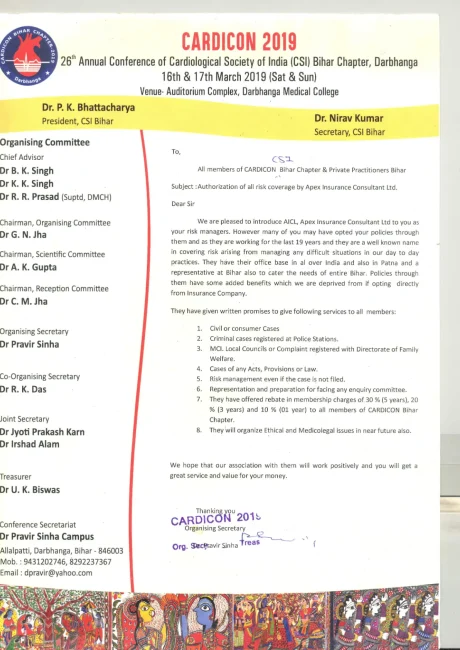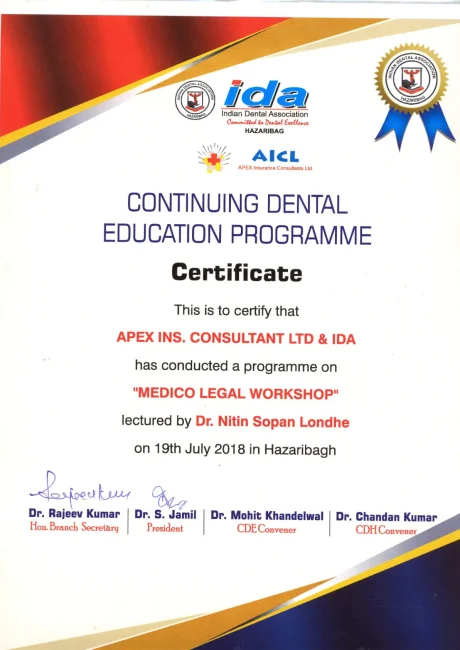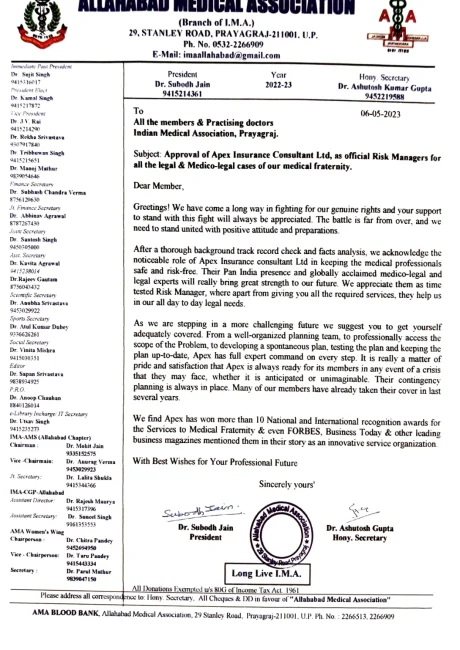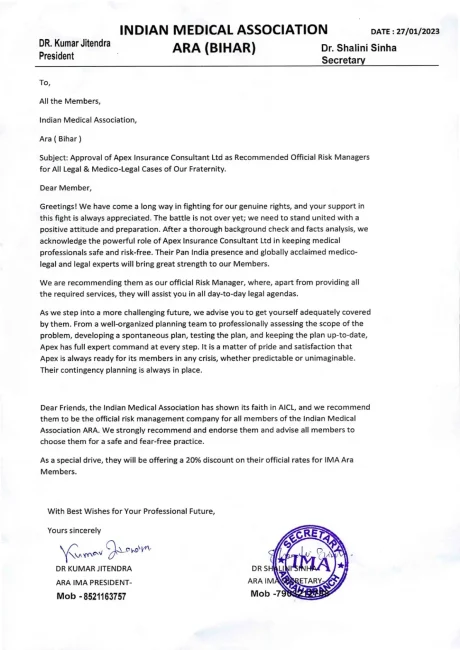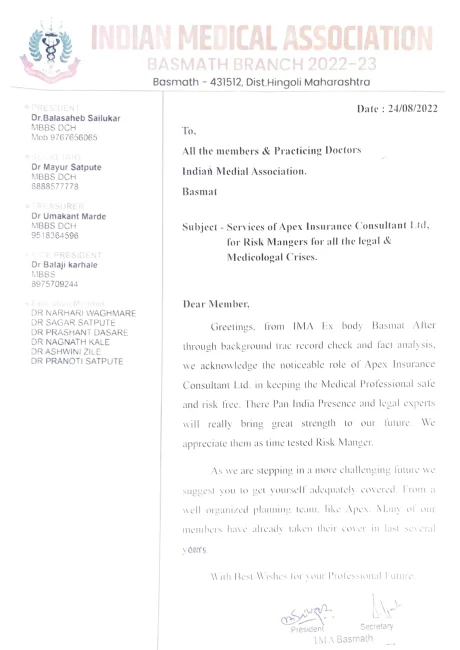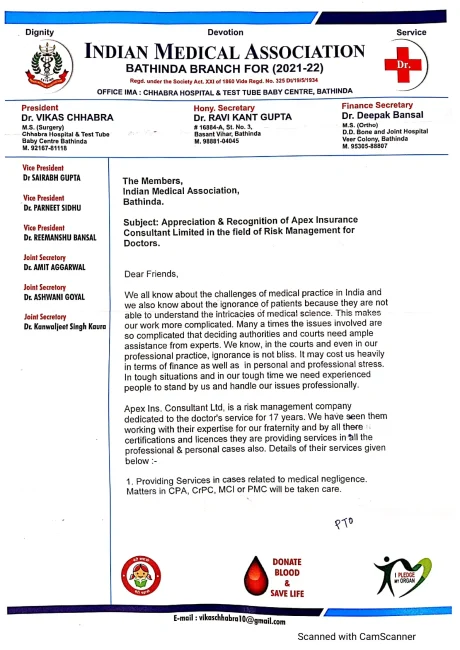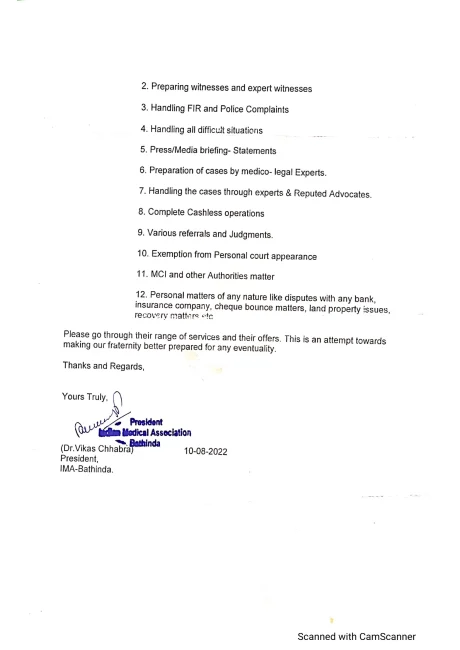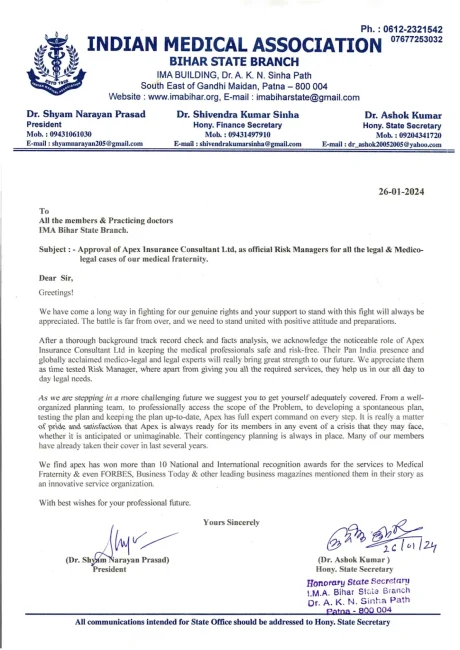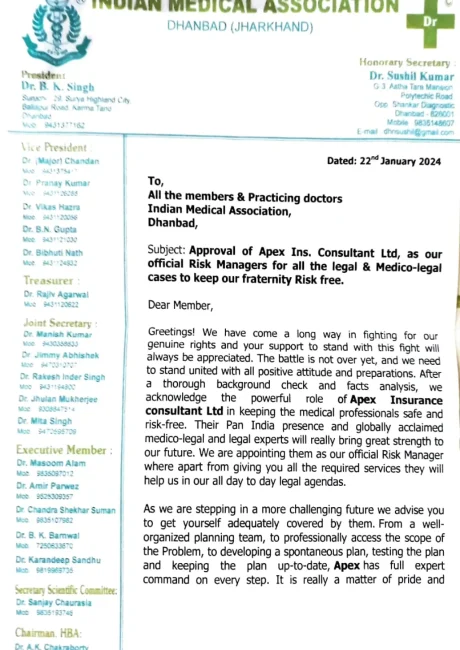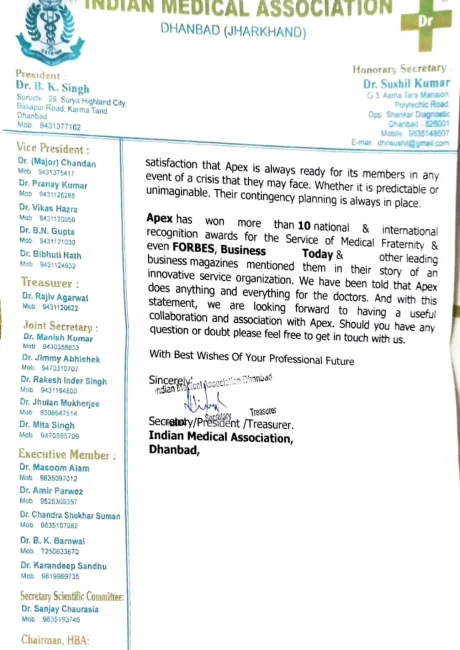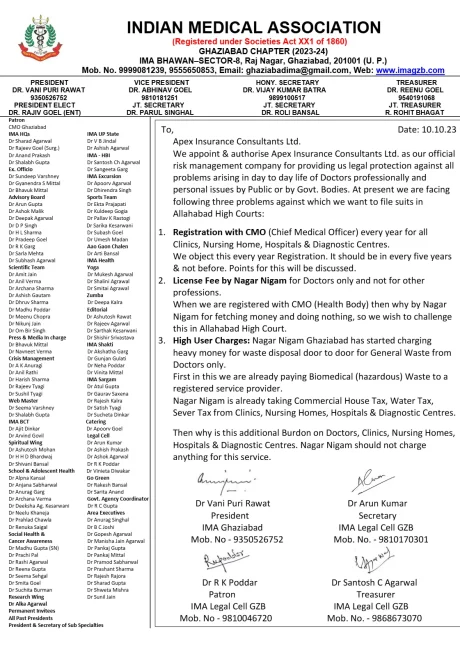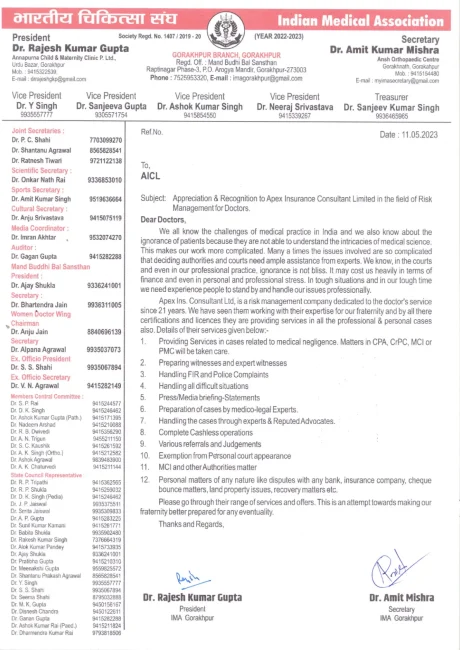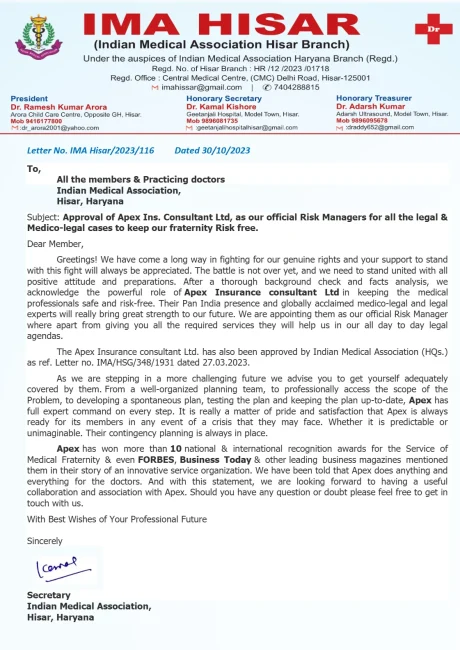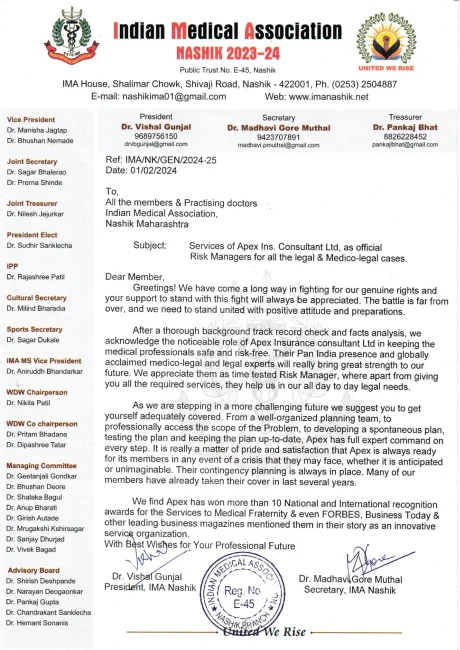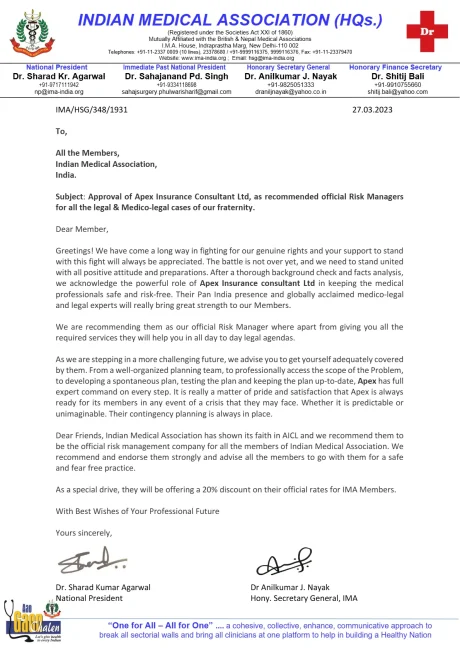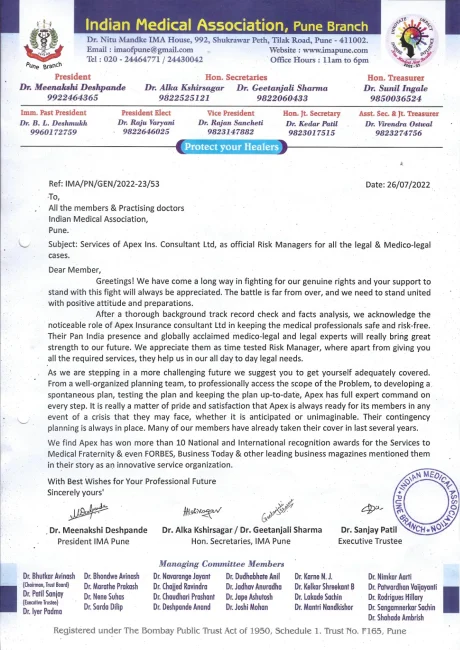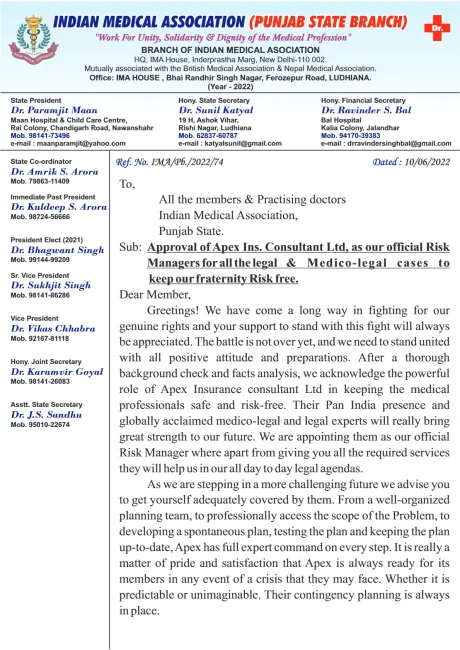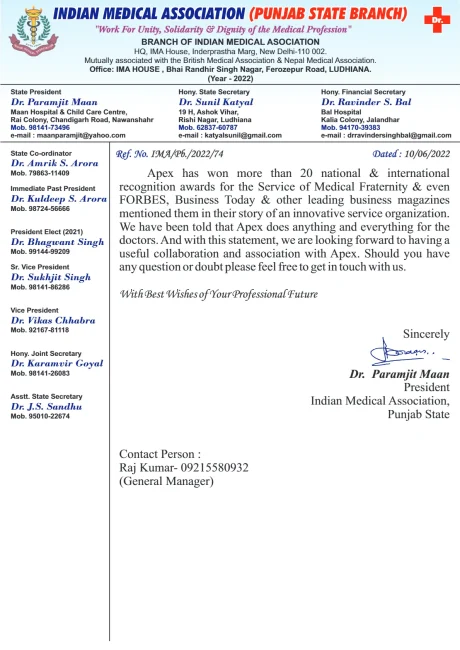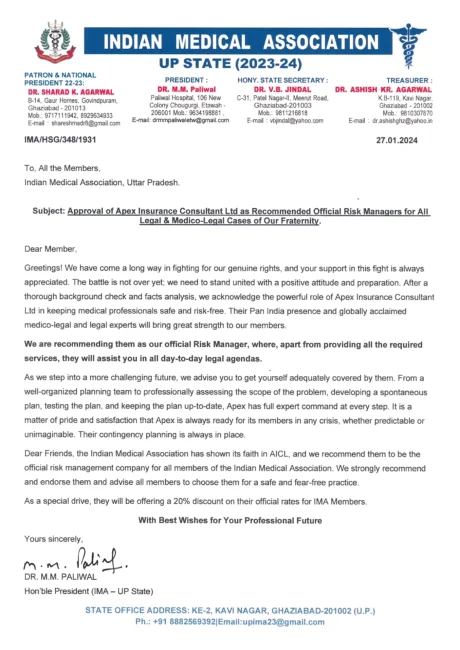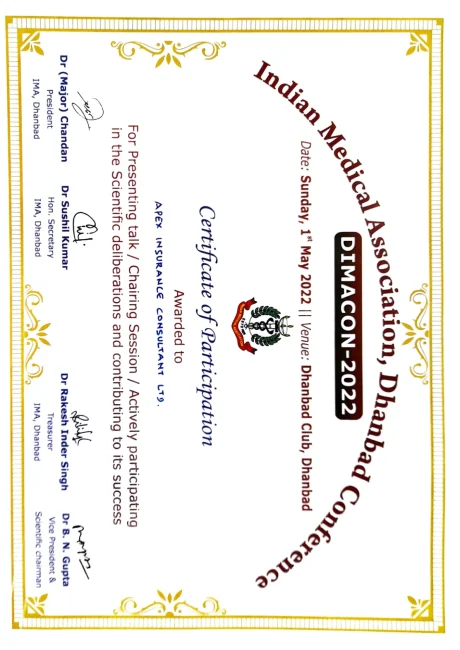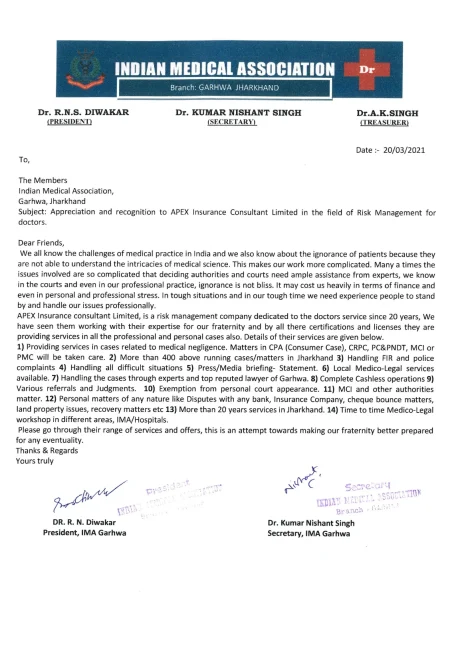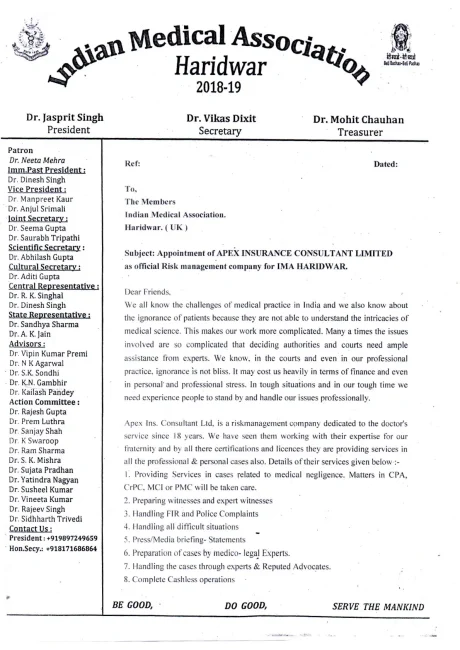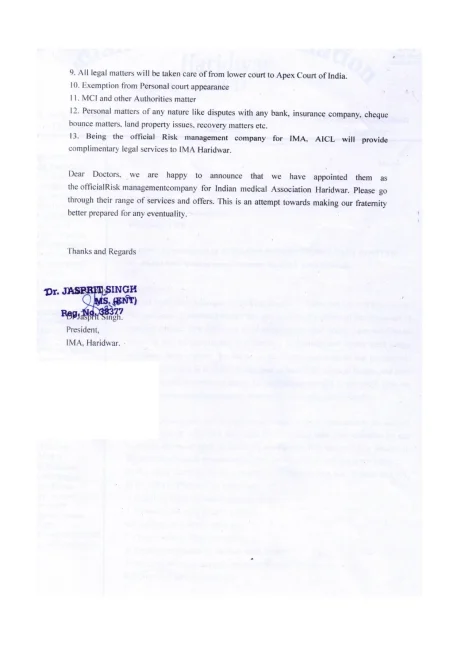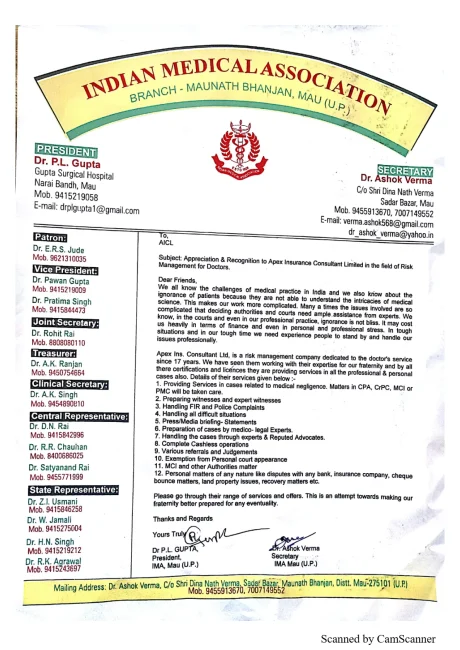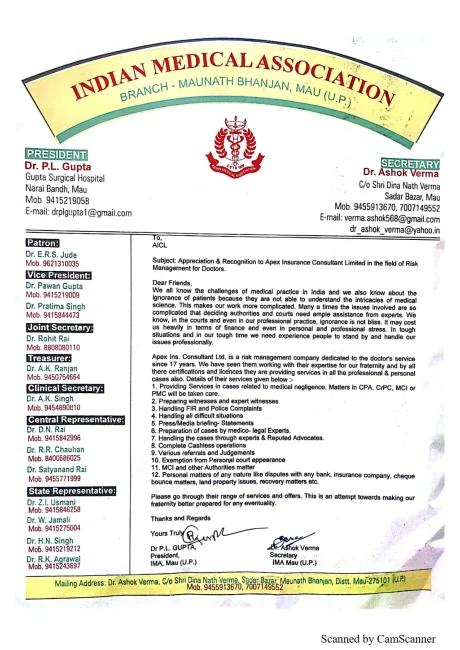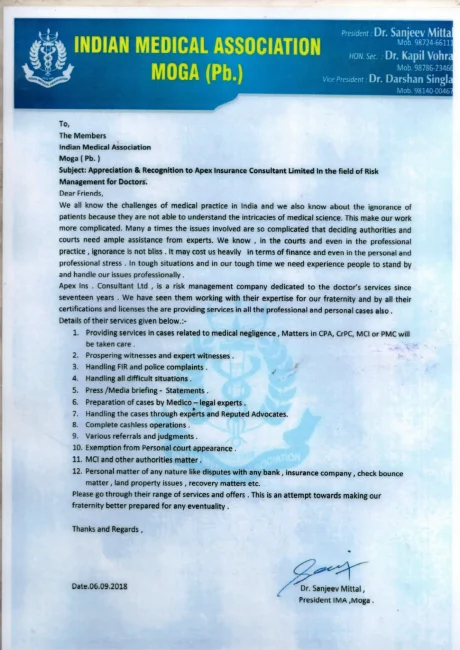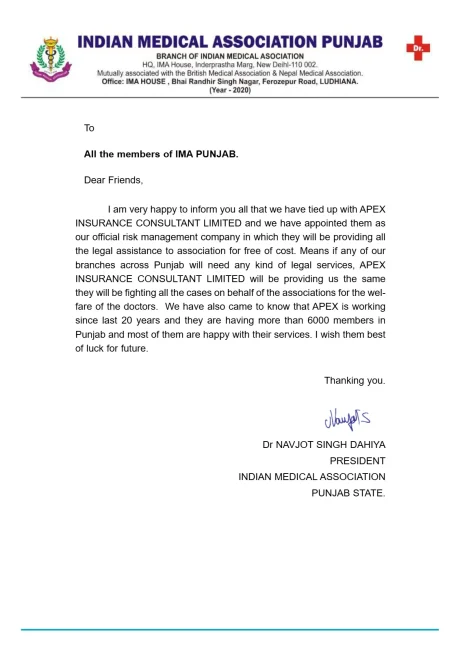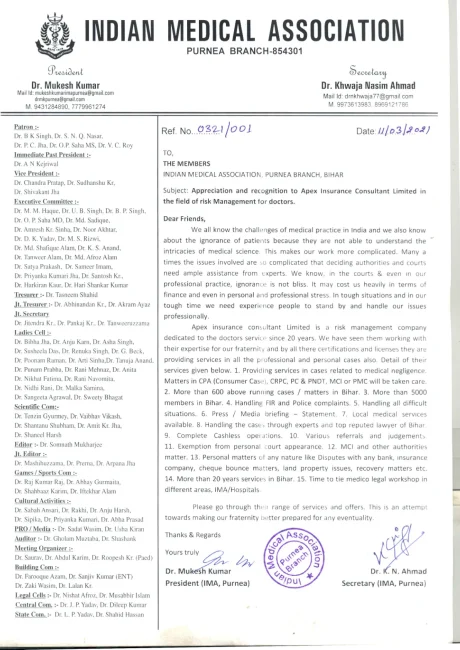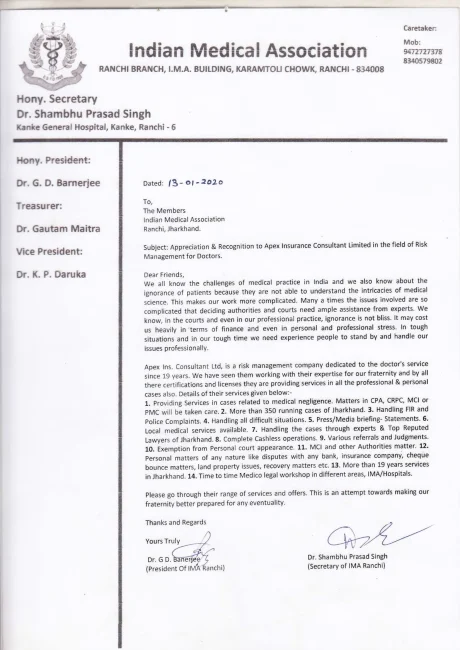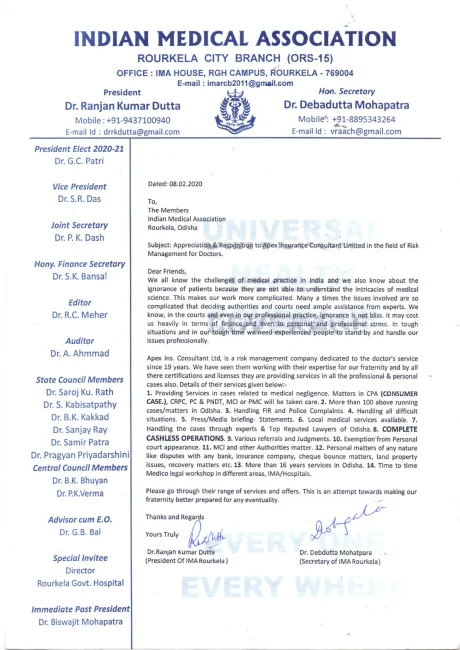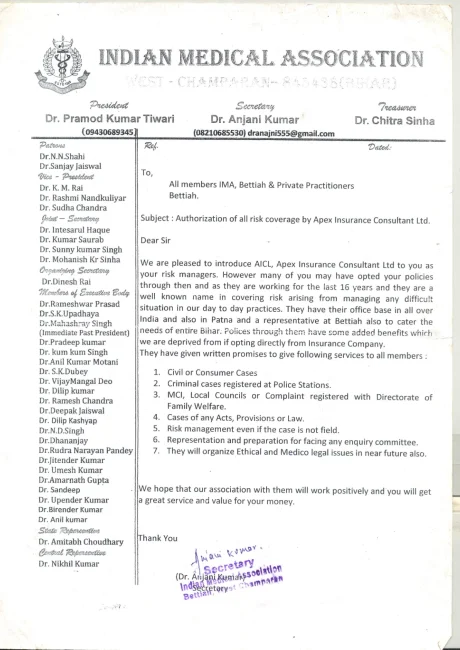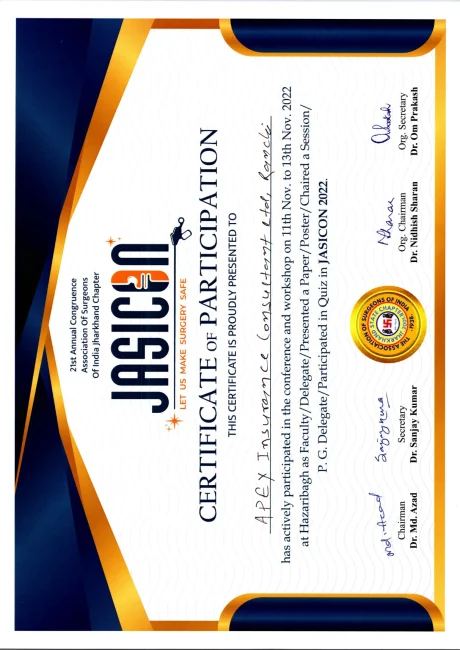By Dr. (Prof.) Mahesh Baldwa, M.D, D.C.H, FIAP, MBA, LL.B, LL.M, PhD (law)
SENIOR PEDIATRICIAN & MEDICOLEGAL ADVISOR
Dr Sushila Baldwa, MBBS, MD,DGO, senior gynecologist,
Baldwa Hospital, Sumer Nagar, S.V. Road, Borivali (West) Mumbai 400 092
2. Dr Namita Padvi, MBBS, MD,DNB, PGDML, Fellowship in pediatric anesthesiology, Assistant Professor of Pediatric medical s at T.N. Pediatric medical College and Nair Hospital, Mumbai-400008
3. Dr Varsha Gupta, MBBS, MD, PGDML, Senior resident in department of pathology, Government medical college, kota, Rajasthan
Introduction
The Doctor patient relationship in our country has undergone a sea change in the last decade and a half. The lucky doctors of the past were treated like God and people revered and respected them. We witness today a fast pace of commercialization and globalization on all spheres of life and the medical profession is no exception to these phenomena. As a result, the doctor-patients relationship has deteriorated considerably.
The Consumer Protection Act, 1986 (24th December 1986 notified in gazette on 15-4-1987), is applicable whole of India except Jammu and Kashmir. It benevolent social legislation that lays down the rights of the consumers and provides their for promotion and protection of the rights of the consumers. The Act for the first time introduced the concept of ‘consumer’ and conferred express additional rights on him. It is interesting to note that the Act doesn’t seek to protect every consumer within the literal meaning of the term. The protection is meant for the person who fits in the definition of ‘consumer’ given by the Act. The Act has been amended in 1991 and substantially in 1993 and 2003, with a view to making it more effective in bringing justice to the door steps of consumers.
Earlier too, doctors were covered by various laws, i.e. the Law of Torts, IPC etc., but since the passing of the Consumer Protection Act in 1986, litigation against doctors is on the increase. The medical profession is definitely perturbed by this and a rethink is necessary on standards of medical practice or ‘defensive medicine’. Sometimes the course of the disease or therapeutic decisions does not run along predictable lines. The patient-doctor relationship is then put to test in court of law.
Consumer awareness
The Act mandates establishment of Consumer Protection Councils at the Centre as well as in each State and District, with a view to promoting consumer awareness.
Central and state Consumer Protection Council
The Central Council is headed by Minster, In-charge of the Department of Consumer Affairs in the Central Government and the State Councils by the Minister In-charge of the Consumer Affairs in the State Governments.
The objectives of the Central and state Council is to promote and protect the rights of the consumers such as:-
- the right to be protected against the marketing of goods and services which are hazardous to life and property.
- the right to be informed about the quality, quantity, potency, purity, standard and price of goods or services, as the case may be so as to protect the consumer against unfair trade practices.
- the right to be assured, wherever possible, access to a variety of goods and services at competitive prices.
- the right to be heard and to be assured that consumer’s interests will receive due consideration at appropriate forums.
- the right to seek redressal against unfair trade practices or restrictive trade practices or unscrupulous exploitation of consumers; and
- the right to consumer education.
- the right against consumer exploitation.
consumer redressal agencies
It also provides for a 3-tier structure of the National and State Commissions and District Forums for speedy resolution of consumer disputes and to provide inexpensive, summary redressal of consumer disputes, quasi-judicial bodies have been set up in each District and State and at the National level, called the District Forums, the State Consumer Disputes Redressal Commissions and the National Consumer Disputes Redressal Commission respectively.
additional legal remedy
The remedy under the Consumer Protection Act is an alternative in addition to that already available to the aggrieved persons/consumers by way of civil suit. In the complaint/appeal/petition submitted under the Act, a consumer is not required to pay any court fees but only a nominal fee .
Consumer Fora proceedings
Consumer Fora proceedings are summary in nature. The endeavor is made to grant relief to the aggrieved consumer as quickly as in the quickest possible, keeping in mind the provisions of the Act which lay down time schedule for disposal of cases.
Appeals
If a consumer is not satisfied by the decision of a District Forum, he can appeal to the State Commission. Against the order of the State Commission a consumer can come to the National Commission.
Network of consumer redressal agencies
At present, there are 629 District Forums and 35 State Commissions with the National Consumer Disputes Redressal Commission (NCDRC) at the apex. NCDRC has its office at Upbhokta Naya Bhawan, ‘F’ Block, GPO Complex, INA, New Delhi-110 023.
Consumer of Medical Services as under CPA, 1986
Earlier, the patients aggrieved by medical negligence did not have any effective adjudicative body for getting their grievances redressed. The Indian Medical Council Act, 1956 as amended in 1964, provides that regulation made by the Council may specify conducts, whose violations shall constitute misconduct. Secondly, the Council was available only at the state headquarters, thereby making it hardly accessible to the majority of parties. Further, the Council has no power to award compensation to the patients for the injury sustained. Maximum medical council can warn the doctor or temporarily suspend registration or permanently deregister leading to professional death sentence.
There are of course provisions in the Civil and Criminal law offering remedies to aggrieved patients. But the Criminal law was pressed into services mostly in case of death as if bodily injury lesser than death has resulted from negligence, then charge would be either simple hurt or grievous hurt. What the law calls criminal negligence is largely a matter of degree, it is incapable of a precise definition. To prove is like chasing a mirage. Further, courts have been very careful not to hold qualified physicians criminally liable for patient’s deaths, resulting from a mere error of judgment in the selection and application of remedies.
How doctors came under the Consumer Protection Act
Initially when it came in to force the doctors were not vendors and patient consumer.It was initiated by Justice V Bala Krishna Eradi, President, NCDRC, on April 21, 1992, delivered a landmark judgment in Cosmopolitan Hospital and Anr. v. Vasantha P. Nair case that doctors were vendors and patient consumer. [Cosmopolitan Hospital and anr. v. Vasantha P. Nair (1992) CPJ 302 NC]. finally supreme court ruled in IMA versus V P shantha case that doctors were vendors and patient consumer in the year 1995 [Indian Medical Association vs V.P. Shantha & Ors on 13 November, 1995: 1996 AIR 550, 1995 SCC (6) 651]
NGO’s and media spreading awareness about rights of patients
Indian’s are made aware regarding patient’s rights by consumer NGO, print media and TV channels. the recent spurt in litigation concerning medical professional and medical establishments liability, alleging suffering caused due to medical negligence and claiming redressal for the, vitiated consent, and breach of confidentiality arising out of the doctor-patient relationship.
Judicial thinking favours right to life
legal machinery is more patient-centric protecting rights of patient. even the Indian Supreme Court’s has voiced to make right to health as a fundamental right by interpreting various articles of Indian Constitution mainly article 21 ensuring right to life.
what doctors should know about The Consumer Protection Act, 1986
Who can file a complaint?
A consumer or any recognized consumer association, i.e., voluntary consumer association registered under the Companies Act, 1956 or any other law for the time being in force, whether the consumer is a member of such association or not, or the central or state government.
Who is a consumer?
Consumer is : (a) a patient who pays to get services of doctor /hospital ; (b) any person who pays for the patient ; (c) legal heirs /representatives of such patients ; (d) spouse, parents and children of the patient.
A consumer is a person who hires or avails of any services for a consideration that has been paid or promised or partly paid and partly promised or under any system of deferred payment and includes any beneficiary of such services other than the person hires or avails of the services for consideration paid or promised, or under any system of deferred payment, when such services are availed of with the approval of the first mentioned person. This definition is wide enough to include a patient who merely promises to pay.
What is a complaint?
A complaint is an allegation in writing made by a Complainant, i.e., a consumer that he or she has suffered loss or damage as a result of any deficiency of service.
What is deficiency of service?
Deficiency of service means any fault, imperfection, shortcoming, or inadequacy in the quality, nature, or manner of performance that is required to be maintained by or under any law for the time being in force or has been undertaken to be performed by a person in pursuance of a contract or otherwise in relation to any service.
Where is a complaint filed?
A complaint can be filed in 1) the District Forum if the value of services and compensation claimed is less than 20 lakh rupees, 2) before the State Commission, if the value of the goods or services and the compensation claimed does not exceed more than 1 crore rupees, or 3) in the National Commission, if the value of the goods or services and the compensation exceeds more than 1 crore rupees. appeal can be filed to supreme court against order of National Commission.
What is the cost involved in filing a complaint?
| Sl. No. | Total Value of goods or services and the compensation claimed | Amount of fee payable |
| District Forum | ||
| (1) | Upto one lakh rupees – For complainants who are under the Below Poverty Line holding Antyodaya Anna Yojana Cards | Nil |
| (2) | Upto one lakh rupees – For complainants other than Antyodaya Anna Yojana card holders. | Rs.100 |
| (3) | Above one lakh and upto five lakh rupees | Rs.200 |
| (4) | Above five lakh and upto ten lakh rupees | Rs.400 |
| (5) | Above ten lakh and upto twenty lakh rupees | Rs.500 |
| State Commission | ||
| (6) | Above twenty lakh and upto fifty lakh rupees | Rs.2000 |
| (7) | Above fifty lakh and upto one crore rupees | Rs.4000 |
| National Commission | ||
| (8) | Above one crore rupees | Rs.5000 |
Is there any provision for appeal?
An appeal against the decision of the District Forum can be filed before the State Commission. An appeal will then go from the State Commission to the National Commission and from the National Commission to the Supreme Court. The time limit within which the appeal should be filed is 30 days from the date of the decision in all cases.
What are the powers of the consumer redressal forums?
The forums have a variety of powers. They are 1) the summoning and enforcing of the attendance of any defendant doctor or witness and examining the witness under oath, 2) the discovery and production of any document or other material object producible as evidence, 3) the reception of evidence on affidavits, 4) the summoning of any expert evidence or testimony, 5) the requisitioning of the report of the concerned analysis or test from the appropriate laboratory or from any other relevant source, 6) issuing of any commission for the examination of any witness, and 7) any other matter which may be prescribed.
How does adjudication of liability take place?
The process before the competent forum will be set in motion in the following manner. When the Complainant files a written complaint, the forum, after admitting the complaint, sends a written notice to the opposite party asking for a written version to be submitted within 30 days. Thereafter, subsequent to proper scrutiny, the forum would ask for either filing of an affidavit or production of evidence in the form of interrogatories, expert evidence, medical literature, and judicial decisions.
Structure of Consumer Forums / Commissions and Their Jurisdictions
| SUPREME COURT (Final Appeal) | ||
| Appellate Authority over StateCommissionRevisional Jurisdiction | NATIONAL COMMISSION | Original Jurisdiction OverRs.100,00,000 |
| Appellate Authority for District Forum Suo moto Revision | STATE COMMISSION | Original Jurisdiction over Rs. 20,00,000 up to Rs. 100,00,000 |
| DISTRICT FORUM | Original Jurisdiction up to Rs. 20,00,000 |
As per the Consumer Protection Rules, 1987, a complaint filed in the Consumer Forum / Commission shall be adjudicated, within a period of 90 days from the date of notice by opposite party and within 150 days if it requires analysis or testing of commodities.
Limitation Period
The District Forum , the State Commission or the National Commission shall not admit a complaint unless it is filed within 2 years from the date on which the cause of action has arisen. In case there are sufficient grounds for not filing the complaint within such period, extension may be granted.
Dismissal of frivolous or vexatious complaints
Where a complaint instituted before the District Forum, the State Commission or the National Commission, as the case may be, is found to be frivolous or vexatious, it shall, for reasons to be recorded in writing, dismiss the complaint and make an order that the complainant shall pay to the opposite party such cost, not exceeding 10,000 rupees, as may be specified in the order.
Penalties
Where a person against whom a complaint is made or the complainant fails or omits to comply with any order made by the District Forum, the State Commission or the National Commission, as the case may be, such person or complainant shall be punishable with imprisonment for a term which shall not be less than one month but which may extend to three years, or with fine which shall not be less than 2,000 rupees but which may extend to 10,000 rupees or with both. In exceptional circumstances the penalties may be reduced further.
doctor’s medical negligence and The Consumer Protection Act, 1986
Definition
Negligence is simply the failure to exercise due care and caution showing absence of prudence diligence of average practitioner. The following are ingredients of medical negligence :
- There should be doctor patient relationship-implied or written. [doctor patient relationship is described in detail below]
- Duty of reasonable standard of care (actively avoiding all kinds of dangers from all sources all the time by applying proper knowledge and competent use of skill) to your patients (Law asks for care, Law does not ask for cure)
- Do relevant investigations to avoid dangers from disease, drugs or surgery
- When you cannot avoid known dangers then forewarn your patients about commonest ones by obtaining valid informed consent.
- Do proper counseling process about origin of disease, natural history, duration, likely hood of time taken for cure, morbidity and mortality- tell in terms of percentages
- Detect complications of your patients and treat or refer to appropriate specialist
- At least do written record keeping for everything done in closed spaces, where relatives have limited access e.g closed spaces, treatment rooms, O.T. ,etc.
- Monitoring serious patients by keeping record and using available sophisticated gadgets and investigations
- Follow Bolam principle meaning if there are two conflicting views on acceptable standard of medical practice. Doctor may opt for any one of the acceptable and reasonable standards available.
- Breach of duty of care by medical practitioner is actionable only when it causes acceleration of natural disease process, morbidity or mortality due to action or inaction on part of such person.
- Any acceleration process caused due to breach of duty resulting in actual damage to patient is actionable.
- There should be close nexus between acceleration caused by breach of duty and resultant damage
- Legal dictum is if there is No damage, then no compensation is awarded
Doctor patient relationship by implication/ presumption in emergency:
It is well known that a doctor owes a duty of care to his patient. This duty can either be a contractual duty or a duty arising out of tort law. In some cases, however, though a doctor-patient relationship is not established, the courts have imposed a duty upon the doctor. In the words of the Supreme Court “every doctor, at the governmental hospital or elsewhere, has a professional obligation to extend his services with due expertise for protecting life” [Pt. Parmanand Katara vs Union Of India & Ors on 28 August, 1989: 1989 AIR 2039, 1989 SCR (3) 997]. These cases are however, clearly restricted to life saving situations where there is danger to the life of the person.
In the case of Pravat Kumar Mukherjee vs. Ruby General Hospital & Ors7, the patient was brought to Ruby General Hospital and it was an emergency case beyond any doubt. The doctors assisted the patient but as there was no guardian and a passerby admitted the patient, the doctors contended that as there was no consent for paying up the requisite fees for medical help so it was stopped hence forth. This led to the death of the young boy. At that moment, the passerby, who admitted the patient, was not in a position to pay Rs.15000. But as doctor, the person is supposed to know his mission and on humanitarian grounds should have started providing the medical treatment. Further, when the treatment started, it would mean that the patient has hired the service and would have paid back the required sum in due course of time.
Doctor – Patient Relationship
Since the ancient times, certain duties and responsibilities have been cast on persons who adopt the sacred profession as exemplified by Charak’s Oath ( 1000 B.C.) and Hippocratic Oath ( 460 B.C.). In order to understand the complexities of the doctor-patient relationship it is necessary to know about the Duties and Obligations of a Doctor, Doctor-Patient contract and what constitutes Professional Negligence.
Prerequisites of Medical Practice
A duly qualified medical professional, i.e. a doctor has a right to seek to practice medicine, surgery and dentistry by registering himself with the Medical Council of the State of which he is a resident, by following the procedure as prescribed under the Medical Act of the State.
The State Medical Council has the power to warn, refuse to register / remove from register the name of the doctor who has been sentenced by any court for any non-bailable offence or found to be guilty of infamous conduct in any professional respect. The State Medical Council has also the power to re-enter the name of the doctor in the register.
The provisions regarding offences and professional misconduct which may be brought before the appropriate Medical Council (State/Medical Council of India ) have been stated in the Code of Medical Ethics formulated by the Medical Council of India.
The appropriate Medical Councils are empowered to award such punishment as deemed necessary or direct the removal of the name of the delinquent registered practitioner from the register either permanently or for a specified period, if he has been found guilty of serious professional misconduct. No action against a medical practitioner can be taken unless an opportunity has been given to him to be heard in person or through an advocate.
Duties and Obligations of a Doctor
Duties and obligations of doctors are enlisted in ordinary laws of the land and various Codes of Medical Ethics and Declarations – Indian and International, which are :
(i) Code of Medical Ethics of Medical Council of India ;
(ii) Hippocratic Oath ;
(iii) Declaration of Geneva ;
(iv) Declaration of Helsinki;
(v) International Code of Medical Ethics ;
(vi) Government of India Guidelines for Sterilization.
These Codes and Declarations are being printed in the Appendices. On the basis of these various Codes of Ethics and Declarations, the duties can be summarised as under –
1. Duties to Patient.
2. Duties to Public.
3. Duties towards Law Enforcers.
4. Duties not to violate Professional Ethics.
5. Duties not to do anything illegal or hide illegal acts.
6. Duties to each other.
1. Duties to Patient – These are : Standard Care, Providing Information to the Patient /Attendant Consent for Treatment, and Emergency Care.
(A) Standard Care – This means application of the principles of standard care which an average person takes while doing similar job in a similar situation :
1. Due care and diligence of a prudent Doctor.
2. Standard, suitable, equipment in good repair.
3. Standard assistants : Where a senior doctor delegates a task to a junior doctor or paramedical staff, he must assure himself that the assistant is sufficiently competent and experienced to do the job, and fulfills the prescribed qualifications.
4. Non-standard drug is a poison by definition.
5. Standard procedure and indicated treatment and surgery.
6. Standard premises, e.g. Nursing Home, Hospital , must comply with all laws applicable as imposed by the State and these must be registered wherever required.
7. Standard proper reference to appropriate specialist.
8. Standard proper record keeping for treatment given, surgery done, X-ray and pathological reports.
9. Standard of not to experiment with patient
10. Anticipation of standard risks of complications and preventive actions taken in time.
11. Observe punctuality in consultation.
(B) Duty to provide information to patient / attendant
1. Regarding necessity of treatment.
2. Alternative modalities of treatment.
3. Risks of pursuing the treatment, including inherent complications of drugs, investigations, procedure, surgery etc.
4. Regarding duration of treatment.
5. Regarding prognosis. Do not exaggerate nor minimize the gravity of patient’s condition.
6. Regarding expenses and break-up thereof.
(C) Consent for treatment – Various types of consent and implications thereof are discussed in
(D) Emergency Care – A doctor is bound to provide emergency care on humanitarian grounds, unless he is assured that others are willing and able to give such care. It may be noted that prior consent is not necessary for giving emergency / first-aid treatment. In emergency medico-legal cases, condition of first being seen by medical jurist is not essential.
2. Duties to the Public
1. Health Education
2. Medical help when natural calamities like drought, flood, earth-quakes, etc. occur.
3. Medical help during train accidents.
4. Compulsory notification of births, deaths, infectious diseases, food poisoning etc.
5. To help victims of house collapse, road accidents, fire, etc.
3. Duty towards Law Enforcers, Police, Courts, etc.
1. To inform the police all cases of poisoning, burns, injury, illegal abortion, suicide, homicide, manslaughter, grievous hurt and its natural complications like tetanus, gas-gangrene , etc. This includes vehicular accidents, fractures, etc.
2. To call a Magistrate for recording dying declaration.
3. To inform about bride burning and battered child cases.
4. Duty not to violate Professional Ethics ( Only important few given)
1. Not to associate with unregistered medical practitioner and not allow him to practice what he is not qualified for.
2. Not to indulge in self-advertisement except such as is expressly authorized by the M.C.I. Code of Medical Ethics.
3. Not to issue false certificates and bills.
4. Not to run a medical store / open shop for sale of medical and surgical instruments.
5. Not to write secret formulations.
6. Not to refuse professional service on grounds of religion, nationality, race, party politics or social status.
7. Not to attend patient when under the effect of alcohol
8. No fee sharing ( Dichotomy).
9. Not to talk loose about colleagues.
10. Information given by patient /attendant to be kept as secret. Not to be divulged to employer, insurance company, parents of major son/daughter without consent of patient. Even in court this information is given only if ordered by the Court.
11. Recovering any money ( in cash or kind) in connection with services rendered to a patient other than a proper professional fee, even with the knowledge of the patient.
5. Duty not to do anything illegal or hide illegal acts
1. Perform illegal abortions / sterilization’s
2. Issue death certificates where cause of death is not known.
3. Not informing police a case of accident, burns, poisoning, suicide, grievous hurt, gas gangrene.
4. Not calling Magistrate for recording dying declaration.
5. Unauthorized, unnecessary , uninformed treatment and surgery or procedure.
6. Sex determination (in certain States).
6. Duty to each other
1. A doctor must give to his teachers respect and gratitude.
2. A doctor ought to behave to his colleagues as he would like them to behave to him.
3. A doctor must not entice patients from his colleagues, even when he has been called as a specialist.
4. When a patient is referred to another doctor, a statement of the case should be given. The second doctor should communicate his opinion in writing /over telephone/fax direct to the first doctor.
5. Differences of opinion should not be divulged in public.
6. A doctor must observe the principles enunciated in ‘The Declaration of Geneva’ approved by the World Medical Association.
Duties of the Patient / Attendant
When a patient ( consumer ) hires or avails of services of a doctor for treatment, he has the following duties :-
1. He must disclose all information that may be necessary for proper diagnosis and treatment.
2. He must co-operate with the doctor for any relevant investigations required to diagnose and treat him.
3. He must carry out all the instructions as regards drugs, food, rest, exercise or any other relevant /necessary aspect.
4. In the case of a private medical practitioner he must compensate the doctor in terms of money and money alone. Moral considerations apart, failure on the part of the patient / attendant to do his duty :
(a) will enable the doctor to terminate patient -physician contract and that would free him from his legal responsibilities,
(b) will be construed as contributory negligence, and weaken the case of the patient for compensation.
Doctor – Patient Contract
Contract is defined as an agreement between two or more persons which creates an obligation to do or not to do a particular thing. Contract may be implied or express.
An implied contract is one inferred from conduct of parties and arises where one person renders services under circumstances indicating that he expects to be paid thereof, and the other person knowing such circumstances, avails himself of benefit of those services.
An express contract is an actual agreement of the parties, the terms of which are openly uttered or declared at the time of making it, being stated in distinct and explicit language, either orally (oral agreement ) or in writing (written agreement).
The doctor-patient contract is almost always of the implied type, except where a written informed consent is obtained.
While a doctor cannot be forced to treat any person, he has certain possibilities for those whom he accepts as patients. It is an implied contract. Implied contract is not established when :
(i) the doctor renders first-aid in an emergency ;
(ii) he makes a pre-employment medical examination for a prospective employer;
(iii) he performs an examination for life insurance purpose ;
(iv) he is appointed by the trial court to examine the accused for any reason ; and
(v) when he makes an examination at the request of an attorney for last suit purposes. A doctor-patient contract requires that the doctor must :
(1)continue to treat such a person ;
(2) with reasonable care ;
(3)reasonable skill ;
(4) not undertake any procedure/ treatment beyond his skill and
(5) must not divulge professional secrets.
These various requirements will now be discussed in the succeeding paragraphs.
(i) Continue to Treat – Responsibility towards a patient begins the moment a doctor agrees to examine the case. He must not, therefore, abandon his patient except under the following circumstances –
1. The patient has recovered from the illness, for which treatment was initiated.
2. The patient / attendant does not pay the doctor’s fees (in case of a private practitioner).
3. The patient / attendant consults another doctor ( of any branch of medicine ) without the knowledge of the first attending doctor.
4. The patient / attendants do not co-operate and follow the doctor’s instructions.
5. The patient is under some other responsible care, e.g., the patient, after admission in a hospital, comes under care of senior doctors / unit head.
6. The doctor has given due notice (orally or written ) for discontinuing treatment.
7. The doctor is convinced that the illness is a fictious one.
(ii) Reasonable Care – A doctor must use clean and proper instruments, and provide his patients with proper and suitable medicines if he dispenses them himself. If not, he should write the prescriptions legibly,using standard abbreviations and mention instructions for the pharmacist in full. He should give full directions to his patients as regards administration of drugs and other measures,preferably in local written language. He must suggest / insist on consultation with a specialist in the following circumstances :
1. When the case is complicated.
2. When the question arises about performing an operation which may be dangerous to life or requiring amputation.
3. Operating on a case in which there has been a criminal assault.
4. Performing an operation which may affect the intellectual or reproductive functions of a patient.
5. In cases where there is suspicion of poisoning or other criminal act.
6. When desired by the patient / attendants.
7. When it appears that the quality of medical service is required to be enhanced.
8. When there is no one from whom informed consent can be obtained.
(iii) Reasonable Skill – The degree of skill a doctor undertakes is the average degree of skill possessed by his professional brethren of the same standing as himself. The best form of treatment may differ when different choices are available. There is an implied contract between the doctor and the patient when the patient is told in effect : “Medicine is not an exact science. I shall use my experience and best judgement and you take the risk that I may be wrong. I guarantee nothing.”
(iv) Not to undertake any procedure beyond his skill – This depends upon his qualifications, special training and experience. The doctor must always ensure that he is reasonably skilled before undertaking any special procedure / treating a complicated case. To quote an example, a doctor who is not sufficiently trained or qualified should not administer anaesthesia.
(v) Professional Secrets – A professional secret is one which a doctor comes to learn in confidence from his patients, on examination, investigations or which is noticed in the ordinary privacies of domestic life. A doctor is under a moral and legal obligation not to divulge any such secret except under certain circumstances. This is known as privileged communication which is defined as a communication made by a doctor to a proper authority who has corresponding legal, social and moral duties to protect the public. In must be bonafide and without malice, e.g., as a witness in a court of law; warning partners or spouses of AIDS patients and those found infected with HIV; informing public health authorities of food poisoning from a hotel etc; assisting apprehension of a person who has committed a serious crime ;informing law enforcers about medico-legal cases, etc.
What is the duty owed as per Supreme Court?
The duty owed by a doctor towards his patient, in the words of the Supreme Court is to “bring to his task a reasonable degree of skill and knowledge” and to exercise “a reasonable degree of care” in Laxman Balkrishna Joshi vs Trimbak Bapu Godbole And Anr on 2 May, 1968: 1969 AIR 128, 1969 SCR (1) 206. The doctor, in other words, does not have to adhere to the highest or sink to the lowest degree of care and competence in the light of the circumstance. A doctor, therefore, does not have to ensure that every patient who comes to him is cured. He has to only ensure that he confers a reasonable degree of care and competence.
What is the Standard of Care?
It is now a settled principle of law that a medical practitioner will bring to his task a reasonable degree of skill and knowledge and must exercise a reasonable degree of care. Neither the very highest nor the very lowest degree of care and competence judged in the light of circumstances in each case is what the law requires. Judged from this yardstick, post-operative infection or shortening of the leg was not due to any negligence or deficiency in service on the part of the opposite party Appellant. Deficiency in service thus cannot be fastened on the opposite party in Dr. Kamta Prasad Singh v. Nagina Prasad. 2000;(III) CPJ 283 (WB)
In a case that led to visual impairment as a side effect, the following observations were made. The literature with regard to Lariago clearly mentioned that the side effect of this medicine if taken for a longer duration can affect eyesight but this is not a fact in this case. Besides, there is no expert evidence on record to show that use of this medicine caused damage to the patient’s eyesight. Even for argument’s sake, if it is accepted that this medicine caused damage to the patient’s eyesight, if the Respondent-doctor is one who has advised his patient to use this medicine after an examination in which he found the patient to be suffering from malaria, in that case as well the doctor-Respondent cannot be held guilty of negligence or deficient in his service. However, as stated above in this case the medicine has been used by the patient in low doses for a few days and there is no expert evidence to show that the use of medicine has affected his eyesight. Therefore, the Complainant-Appellant has failed to prove that the Respondent was negligent and deficient in his duty as a doctor in Ajay Kumar v. Dr. Devendra Nath. 2004;(II) CPJ 482.
Reasonable or standard of degree of care
Reasonable degree of care and skill means that the degree of care and competence that an “ordinary competent member of the profession who professes to have those skills would exercise in the circumstance in question.” At this stage, it may be necessary to note the distinction between the standard of care and the degree of care. The standard of care is a constant and remains the same in all cases. It is the requirement that the conduct of the doctor be reasonable and need not necessarily conform to the highest degree of care or the lowest degree of care possible. The degree of care is a variable and depends on the circumstance. It is used to refer to what actually amounts to reasonableness in a given situation. Thus, though the same standard of care is expected from a general physician and a specialist, the degree of care would be different.
The degree of care
In other words, general physician and a specialist are expected to take reasonable care but what amounts to reasonable care with regard to the specialist differs from what amount of reasonable care is standard for the generalist. In fact, the law expects the specialist to exercise the ordinary skill of this specialty and not of any ordinary doctor. Though the courts have accepted the need to impose a higher degree of duty on a specialist, they have refused to lower it in the case of fresh and new doctors.
Level of knowledge that is expected from a doctor.
Should it include the latest developments in the field, hence require constant updating or is it enough to follow what has been traditionally followed? It has been recognized by the courts that what amounts to reasonableness changes with time. The standard, as stated clearly herein before requires that the doctor possess reasonable knowledge. Hence, a doctor has to constantly update his knowledge to meet the standard expected of him. Since only reasonable knowledge is required, it may not be necessary for him to be aware of all the developments that have taken place in field on medicine.
No need to apply every latest modality of investigation / treatment of latest journals ( Crawford’s principle), use what is currently available locally.
In Crawford v. Board of Gov. Of Charring hospital,1953,The Times 8th December(CA) Anesthetist causing mal-positioning of arm causing paralysis. It is not necessary to follow every new modality of investigation or management, which is latest by reading journals at the same time outdated treatment should not be followed pig headedly eg. Prescribing phynylbutazone for arthritis.
In Vinitha Ashok v laxmi Hospital,(Supreme Court of lndia) (SC)I(2002)CPJ,4 In Cervical pregnancy doctors did not do USG. Supreme court said not necessary to follow each and every latest investigations, held not negligent inspite of MTP bleeding controlled by cesarean hysterectomy. Hysterectomy was done for saving life of patient.
Bolams principle or Bolams standard [when there two acceptable and reasonable standards available to doctor]:
The application of the Bolam principle means that where there are two conflicting views on acceptable medical practice. The Bolam principle may be formulated as a rule that a doctor is not negligent if follows one of the acceptable and reasonable standards available.
In Bolam v. Friern Hospital management committee (1957) 1WLR 582, Psychiatrist in England had divided opinion about giving anesthesia for ECT. Proponents of anesthesia felt it is safer for patients. Opponents felt anesthesia reduces the ECT effectiveness. Both were well accepted views. Patient alleged that since anesthesia for ECT was not given so physical restraint caused fractures of jaw and leg bones. Court said doctor has followed one of the peer approved forms of treatment so not negligent.
in Dr. NT Subramaniaum v. Dr. B Krishna Rao 1996 CPJ 233,NC–patient alleged why instead of latest sclerotherapy of varieces trouble some sengstaken tube was utilized to control bleeding varices. Court said both are peer approved forms of treatment and doctors can choose any one, case dismissed.
Standards proclaimed must be authoritative medical body of immediate colleagues.
In Bolitho v City and Hackney Health Authority, 4 All ER 771 (1997, imposes a requirement that the standards proclaimed must be justified on a logical basis and must have considered the risks and benefits of competing options. Thus with no clear medical definition for standard of care, it remains unclear how this mainly legal concept of standard of care weighs up and compares in status to consensus statements or clinical guidelines that are secured in evidence-based medicine and produced by a representative organization or authoritative medical body of immediate colleagues. Bolam followed in India not Bolitho.
Contributory / absolute negligence on the part of patient
Always give written instruction about food, drugs, rest, investigations, surgery, preoperative fasting, vaccinations, known complications and also take Witten consent, Witten refusal or Witten transfer or Witten referral to prove Contributory or absolute negligence of patient party.
In PN Sudhakar Gupta v. Anugraha V. Nursing Home, Daughter developed fever. Admitted and treated for “Typhoid” Condition did not improve. Investigations strongly suggested leukemia. Bone marrow refused by father. Father opted to go to KM institute of Oncology. Did not go there. Later came back for treatment to same doctor but ultimately shifted to KMOI.
Got discharged from KMIO. Died two days later. Father responsible for not following instructions of doctor. Doctors did their best in diagnosing, investigating and treating this patient. No negligence.
Doctrine of avoidable consequences further worsening cause of action
Sometimes the instruction, medications, surgery to avoid further damage or worsening/deterioration in health condition are not followed by patient party and same becomes new cause for worsened health condition of patient and this condition is known as Doctrine of avoidable consequences
Informed consent
Apart from the duty of a doctor with respect to treating and diagnosing the ailment, Doctors are, imposed with a duty to take the consent of a person/patient before performing surgical operations and in some cases invasive or high risk treatment as well. An additional duty of care is imposed on the doctors in taking the patient’s consent. As per the judicial pronouncements, this duty is to disclose all such information as would be relevant or necessary for the patient to make a decision. Therefore, the duty does not extend to disclosing all possible information in this regard. this duty does not extend to warning a patient of all the normal attendant risks of an operation. The standard of care required of a doctor while obtaining consent is again that of a reasonable doctor, as in other cases. Consent should be real as observed by supreme court in Samira Kohli vs Dr. Prabha Manchanda & Anr on 16 January, 2008. Operating beyond consent limits is not permitted in cold cases except in lifesaving situations. Valid Consent should be obtained from adult patient of sound mind. For persons not competent to sign the consent be obtained as proxy consent from natural parents, guardians, defacto parents, loco parentis or consent be substituted by court order.
When does the liability arise?
The liability of a doctor arises not when the patient has suffered any injury, but when the injury has resulted due to the conduct of the doctor, which has fallen below that of reasonable care. In other words, the doctor is not liable for every injury suffered by a patient. He is liable for only those that are a consequence of a breach of his duty. Hence, once the existence of a duty has been established, the patient party / plaintiff must still prove the breach of duty and the causation. In case there is no breach or the breach did not cause the damage, the doctor will not be liable. In order to show the breach of duty, the burden on the patient party plaintiff would be to first show what is considered as reasonable under those circumstances and then that the conduct of the doctor was below this degree. It must be noted that it is not sufficient to prove a breach, to merely show that there exists a body of opinion which goes against the practice/conduct of the doctor.
Cause of action
With regard to causation, the court has held that it must be shown that of all the possible reasons for the injury, the breach of duty of the doctor was the most probable cause. It is not sufficient to show that the breach of duty is merely one of the probable causes. Hence, if the possible causes of an injury are the negligence of a third party, an accident, or a breach of duty care of the doctor, then it must be established that the breach of duty of care of the doctor was the most probable cause of the injury to discharge the burden of proof on the patient party/ plaintiff .
- New cause of action or novus actus interveniens [discontinuity in cause of action]
- Breach of duty of care by medical practitioner is actionable only when it causes acceleration of natural disease process, morbidity or mortality due to action or inaction on part of such person. Any acceleration process caused due to breach of duty resulting in actual damage to patient is actionable. There should be close nexus between acceleration caused by breach of duty and resultant damage. Legal dictum is if there is No damage, then no compensation is awarded. Claim against doctor/hospital usually fails, if it can be proved that there was a break in the chain of causation, novus actus interveniens. This is where an act by a third party supersedes the original negligent act of the OP/doctor/ defendant. The court must decide whether the original act of the defendant was responsible for the damage or if the intervening act constitutes a novus actus interveniens, Dr. S. Gurunathan (Dead) v Vijaya Health Centre, 2002 (3) CPJ(Ncdrc) 211,NC that is, the second act caused the damage. The second act could be an intervening act by a third party or an intervening act by the claimant himself.
Onus of proof
Normally, the liability arises only when the patient party / plaintiff is able to discharge the burden on him of proving negligence.
Negligence speaks for itself
in some cases like a swab left over the abdomen of a patient or the leg amputated instead of being put in a cast to treat the fracture, the principle of ‘res ipsa loquitur’ (meaning thereby ‘the thing speaks for itself’) shifts onus of being not negligent shifts to defendant doctor . The following are the necessary conditions of ‘res ipsa loquitur’ principle.
- patient was under complete control with the defendant doctor like in operation theatre.
- in general surgical operation is not fraught with alleged error/ accident unless there was negligence. This principle is often misunderstood as a rule of evidence, which it is not. It is a principle in the law of torts. When this principle is applied, the burden is on the doctor/defendant doctor to explain how the alleged error/ accident/ incident could have occurred without negligence. In the absence of any such explanation, liability of the doctor arises.
Vicarious liability
Normally, a doctor is held liable for only his acts. In some cases, a doctor can be held liable for the acts of another person which injures the patient. Such a liability may arise when the person committing the act is under control of doctor in chief or respondent superior or as captain of ship. Delegation of medical work to junior medical professionals, compounders, nurses, (be those qualified or unqualified staff), employed or contracted or on profit sharing basis, The medical professional owes vicarious liability to patient on the basis of sound legal principle that, one can delegate medical work not responsibility. The subordinate doctor under supervision of senior surgeon may not owe a duty of care at all to the patient directly in surgical operation, if any negligence. The senior doctor is vicariously liable for subordinate doctor’s negligence.
In a sterilization failure case in government hospital though state was vicariously liable but held there was no negligence of doctor hence reversed high court judgement in State Of Punjab vs Shiv Ram & Ors on 25 August, 2005 .
in Mr. M Ramesh Reddy v. State of Andhra Pradesh [2003 (1) CLD 81 (AP SCDRC)], the hospital authorities were held to be negligent, inter alia, for not keeping the bathroom clean [in this case the bathroom was covered with fungus and was slippery], which resulted in the fall of an obstetrics patient in the bathroom leading to her death. Hospital was vicariously liable. A compensation of Rs. 1 Lac was awarded against the hospital.
in P M Ashwin V. Manipal Hospital Banglore , 1997 (1) CPJ 238:1997(1) CPR 393 ( Karnataka SCDRC), 65 days old operated for Rt. Inguinal hernia. Due to negligence of nurse, an extremely hot bag kept under child’s leg, legs burnt, prolonged treatment, permanent scars, and permanent disability. Doctor, hospital vicariously responsible for accidental burns due to hot water bag by unqualified nurse. Compensation of Rs12.5 lakhs.
In Spring Meadows Hospital v. Harjot singh Ahluwalia, 1998 (3) CPJ 1 (SC)
Unqualified Nurse gave inj Chloroquin instead of chloramphenicol IV bolus to 2 years 6 months old boy, resultant cardiac arrest. Child revived but severe brain damage-vegetative life. Doctor, hospital vicariously responsible for unqualified nurse Awarded 17.5 lakhs
In A.M. Mathew v. Director, Karuna Hospital, 1998 (1) CPJ 476:1998 (1) CPR 39 Kerla SCDRC
8 & ½ years old son had fever and tonsillitis. On advise of medical professional staff nurse gave injection paracetamol on left buttock. Boy developed foot drop. Neurologist diagnosed sciatic nerve palsy. Dr. Lucy Jacob, medical professional said this was accepted complication. Staff nurse was unqualified. So not qualified to administer injection. Doctor, hospital vicariously responsible for unqualified nurse. This is also known as Actionable negligence. Awarded 1.06 lakh
Responsible for nursing and other staff
The hospital authorities are not only vicariously responsible for their nursing and other staff, doctors, etc. but also for the anesthetists and surgeons, who practice independently but admit/ operate a case in that hospital. In many cases of negligence against government hospitals, it has been held that the State is vicariously liable for negligence of its doctors or staff or even primarily liable where there is lack of proper equipment or staff.
negligence per say means if one is not qualified in any pathy or system of medicine or crosses the line of pathy. It requires doctor to work and cross pathy practice and sometimes cross specialty practice may amount to deficiency in service or unfair trade practice if not negligence.
- Do Work within the scope of one’s qualification and skills acquired by you
- Do not hold out to people at large what you cannot do and for what one is not qualified to do.
In Poonam Verma vs. Ashwin Patel 1996 AIR 2111, 1996 SCC (4) 332, homeopathic doctor prescribed amoxicillin and parcetamol to fever patient, the Supreme Court made its famous observation: A person who does not have the knowledge of a particular system of medicine but practices in that system is a quack and a mere pretender to medical knowledge or skill, or to put it differently,a charlatan,
In Dr. S N Namboodiri V. Haneefa, 1998 (1) CPJ 389 Kerala SCDRC
Ayurvedic doctor giveg paracetamol as treatment for fever with jaundice to 4 & ½ years Haneefa’s daughter with allopathic and ayurvedic drugs. No improvement. Shifted to medical college, but ultimately expired due to hepatic failure. Dr. Namboodiri DAM & DMS in Ayurvedic System hence not competent to prescribe allopathic medicines like paracetamol. Held negligent. Awarded Rs 40,000/=
Similarly allopathshould not prescribe Liv 52, Septilin, Abana, Rumayog, Thuja etc.
Is Cross specialty allopathic practice negligent wrong?
It requires doctor to work and cross pathy practice and sometimes cross specialty practice may amount to deficiency in service or unfair trade practice if not negligence. Cross specialty is not a legal wrong otherwise it shall mean the higher qualifications render basis qualifications of MBBS redundant. In fact higher qualifications are add on knowledge.
Many of the general Practitioners & Consultants in India are practicing newer advances in the field of allopathic medicine for which they are not MCI qualified but trained under some senior specialty medical teachers. Leave alone Surgeons even MBBS are doing hysterectomy and LSCS, even in government set ups. Physicians practicing cardiology, diabetology, gastroenterology, neurology, rheumatology, hematology, chest medicine. Gynecologists running Neonatal Intensive care without having full time Pediatrician or Surgeons doing cesarean sections or Pediatricians conducting deliveries are few of the examples of such cross specialty practice. There are areas related to well established specialty like laparoscopy, endoscopy, sonography, obstetric anesthesia, rheumatology and there is a long list of such specialized subjects, where there are no formal post graduate MCI recognized degree and diploma are not available as on today. Such doctors are in catch 22 situation. Hence Quackery and cross specialty is not synonymous. This is not a new trend emerging in modern medicine. The real concerned is that in old days those Doctors had no choice due to fewer specialists especially in small town or rural area hence cross specialty was alright but today when such specialist are available is crosspathy legally , morally, ethically be allowed?
MD, MS, MCh, DM cannot put MBBS degree and training to dustbin or disallow doctor to treat basic diseases. Every small ailment not falling in the specialty will need reference to appropriate specialist. This will create odious situation. Postgraduate medical education training programs strive to prepare their trainees optimally for independent practice. However, that new consultant’s feel inadequately prepared for specialty practice, and that this increases the risk of stress and burnout.
There is no law that prevents a person who has only an MBBS (and not MD or MS) degree from practicing and even setting up as a specialist in cardiology or ENT, etc. Of course, if a case of negligence is filed against the practitioner, he may be held guilty on account of holding himself out to be an expert in a subject in whom he has not acquired such an expertise.
Services provided by healthcare providers have been the subject matter of judicial review time and again. The Consumer Disputes Redressal Commissions have laid down decisively what is and what is not ‘deficiency’ in the services provided by a healthcare provider. ‘Deficiency’ means, any fault, imperfection, shortcoming or inadequacy in the quality, nature, and manner of performance that is required to be maintained by or under any law.
In Prasanth S Dhanaka v. Nizam institute of medical sciences 1999(1)CPJ 43 NC allegation was Failure to arrange for different specialists care. FNAC report showed shawnnoma. After undergoing operation of intrathoracic tumor benign shawnnoma patient became paraplegic. Knowing that shawnnoma is nerve related tissue doctors should have done preoperative MRI and Myelogram which was not done inspite of rib & vertebral erosion. Nizam institute failed to arrange neurosurgeon from beginning and not referring even after neurological complications occured. Negligence, Pay 15.75 lakhs which was hiked to 1 crore by Supreme Court
Appointing practitioners of Alternative Systems of Medicine
Appointing practitioners of Alternative Systems of Medicine [Ayurveda/ Unani/ Sidha] or Homeopaths in hospitals giving services in allopathy too amounts to negligence. It is the duty of the hospital to provide properly qualified, skilled and experienced doctors for treatment.
When there is no liability: like suffering from complications inherent in case
A doctor is not necessarily liable in all cases where a patient has suffered an injury. This may either be due to the fact that he has a valid medical defense that alleged injury is due to complication arising out of progress of disease / drug reaction treated timely and diligently / surgical complication where doctor has not breached the duty of care. doctor may not be liable if patient suffers from complications inherent in case due to progress of disease / drug reaction treated timely and diligently / surgical complication
Error of judgment
Doctor’s error of judgment in complicated and rare diagnosis and prognosis is acceptable. Error of judgment is not permitted for usual medical and surgical treatment protocols. in Nikhil superspeciality case patient with fever with chills was not treated for malaria even though malaria test was negative was considered negligent by supreme court in spite of expert evidence.
A mere error of judgment occurs when a doctor makes a decision that turns out to be wrong. It is situation in which only in retrospect can we say there was an error. At the time when the decision was made, it did not seem wrong. If, however, due consideration of all the factors was not taken, then it would amount to an error of judgment due to negligence.
Onus of proving negligence is one who alleges
the Complainant has to prove the negligence or deficiency in service by adducing proper evidence and this evidence should be proved beyond all reasonable doubts. Mere allegation of negligence will be of no help to the Complainant.
What Constitutes Medical Negligence?
in Smt. Vimlesh Dixit v. Dr. R.K. Singhal. 2004;(I) CPJ 123 (Uttaranchal) where alleged failure of an operation and side effects were not held negligent. In this case allegation of negligence causing post operative wrist drop. Nothing has been mentioned in the complaint or in the grounds of appeal about the type of care desired from the doctor in which he failed. It is not said anywhere what type of negligence was done during the course of the operation. Nerves may be cut down at the time of operation and mere cutting of a nerve does not amount to negligence. It is not said that it has been deliberately done. To the contrary it is also not said that the nerves were cut in the operation and it was not cut at the time of the accident. Only the report of the Chief Medical Officer of Haridwar has been produced wherein it said that the patient is a case of post-traumatic wrist drop. It is not said that it is due to any operation or the negligence of the doctor. The mere allegation will not make out a case of negligence, unless it is proved by reliable evidence. It is true that the operation has been performed. but unless the negligence of the doctor is proved, she is not entitled to any compensation.
Proof of Medical Negligence
It has been held in different judgments by the National Commission and by the Hon’ble Supreme Court that a charge of professional negligence against a doctor stood on a different footing from a charge of negligence against a driver of a vehicle. The burden of proof is correspondingly greater on the person who alleges negligence against a doctor. It is a known fact that even with a doctor with the best skills, things sometimes go wrong during medical treatment or in a surgery. A doctor is not to be held negligent simply because something went wrong. It is an admitted fact that the Complainant’s eyesight was not restored after the operation was conducted by the Appellant but on this ground alone a doctor cannot be held negligent because even after adopting all necessary precautions and care the result of the operation may not be satisfactory since it depends on various other factors. The contention of the Appellant was that the patient was suffering from diabetes and blood pressure and in many such cases eyesight is not restored after the operation however carefully it is done. In this case, there is nothing on record to show that something went wrong due to an act of the Appellant-doctor. There is no evidence to come to the conclusion that the Appellant fell below the standard of a reasonably competent practitioner in their field, so much so that their conduct might be deserving of censure. The Appellant cannot be liable for negligence because someone else of better skill or knowledge would have prescribed a different method of operation in different way. The evidence suggests that the Appellant has performed the operation and acted in accordance with the practice regularly accepted and adopted by him in this hospital and several patients are regularly treated for their eye problems. The Hon’ble Supreme Court in the case of Dr. Laxman Balkrishna Joshi vs. Dr. Triambak bapu godbole, AIR 1969 Supreme Court page 128 has held the above view and this view has been further confirmed in the case of the Indian Medical Association vs. Shantha. The Apex Court and the National Commission has held that the skill of a medical practitioner differs from doctor to doctor and it is an incumbent upon the Complainant to prove that the Appellant was negligent in the line of treatment that resulted in the loss of eyesight. A Judge can find a doctor guilty only when it is proved that he has fallen short of a standard of reasonable medical care. The fact and circumstances of the case before us show that the Appellant has attended to the patient with due care, skill, and diligence. Simply because the patient’s eyesight was not restored satisfactorily, this account alone is not grounds for holding the doctor guilty of negligence and deficient in his duty. It is settled law that it is for the Complainant to prove the negligence or deficiency in service by adducing expert evidence or opinion and this fact is to be proved beyond all reasonable doubt. Mere allegation of negligence will be of no help to the Complainant in Dr. Akhil Kumar Jain v. Lallan Prasad. 2004;(II) CPJ 504.
The following cases of alleged medical negligence provide an insight into how the final decision is reached by the judicial bodies.
“All medical negligence cases concern various questions of fact, when we say burden of proving negligence lies on the Complainant, it means he has the task of convincing the court that his version of the facts is the correct one”. No expert opinion has been produced by the Complainant to contradict the report of the Board of Doctors. The appeal of the Complainant was dismissed with costs as “No expert opinion has been produced by him.” Amar Singh v. Frances Newton Hospital and Anr. 2001;(I) CPJ 8.In a case of an improper union of the patella, no expert has been produced by the Complainant to prove negligence of the opposite party. Thus, it cannot be said with exactness that treatment of the Complainant by the opposite party was against the norms prescribed under the medical jurisprudence or that the opposite party in any way was negligent or deficient in the performance of his duties.
“Allegation of medical negligence is a serious issue and it is for the person who sets up the case to prove negligence based on material on record or by way of evidence”. The complaint of medical negligence was dismissed because the applicant failed to establish and prove any instance of medical negligence. Mam Chand v. Dr. GS Mangat of Mangat Hospital. 2004;(I) CPJ 79 (NC) “Merely because the operation did not succeed, the doctor cannot be said to be negligent” and the appeal of the doctor was allowed. Dr. (Smt) Kumud Garg v. Raja Bhatia. 2004;(I) CPJ 369.“A mere allegation will not make a case of negligence unless it is proved by reliable evidence and is supported by expert evidence” and the appeal was dismissed. “The commission cannot constitute itself into an expert body and contradict the statement of the doctor unless there is something contrary on the record by way of an expert opinion or there is any medical treatise on which reliance could be based” and the Revision petition of the doctor was allowed. AIR 1989 SC 2039. In another case, an X-ray report indicated a small opacity that similar to an opaque shadow that becomes visible for many causes other than a calculus. It could not be assumed that still stone existed in the right kidney that had not been operated upon. Under the circumstances, we do not think that any case of negligence has been made by the Complainant. This petition is, therefore, allowed. Dr. Harkanwaljit Singh Saini v. Gurbax Singh and Anr. 2003;(I) CPJ 153 (NC)
The Need for Expert Evidence in Medical Negligence Cases
The Commission cannot constitute itself into an expert body and contradict the statement of the doctor unless there is something contrary on the record by way of an expert opinion or there is any medical treatise on which reliance could be based. Dr. Harkanwaljit Singh Saini v. Gurbax Singh and Anr. 2003;(I) CPJ 153 (NC) In this case there was a false allegation of urinary stone not being removed as shown by a shadow in the x-ray “The burden of proving the negligent act or wrong diagnosis was on the Complainant” and the appeal was dismissed in another case of alleged medical negligence as no expert evidence was produced. N S Sahota v. New Ruby Hospital and Ors. 2000;(II) CPJ 345. The case discussed below is not a case of apparent negligence on the part of the surgeon in conducting the operation, but about the quality of the plate used for fixing the bone. In the present case, the Complainant has not produced any expert witnesses to prove that there was any fault in the performance of the operations. Fixation of the bones by using plates is one of the recognized modes of treatment in the case of fracture of the bones. If the opposite party has adopted the aforesaid method, though subsequently the plate broke, negligence cannot be attributed to the doctor. This is not a case where the wounds of the operation were infected or any other complication arose. Breaking of the plate approximately 6 months after it was placed cannot be attributed towards a negligent act of the doctor in performing the operation. The District Forum rightly held that the Complainant had failed to prove his case. Sardool Singh v. Muni Lal Chopra and another. 1999;(I) CPJ 64 (Punjab). There is nothing on the record to suggest that there has been any negligence and/or deficiency in service on the part of the Appellant except the oral submission of the Respondent/Complainant. In such cases, before coming to a positive finding, there must be expert evidence on record as has been held both by the National Commission as well as the Apex Court. Dr. Manjit Singh Sandhu v. Uday Kant Thakur and others. 2002;(III) CPJ 242. “As per the settled law, the onus to prove that there was negligence” deficiency in service on the part of the opposite parties, while diagnosing and treating the Complainant, lay heavily on the Complainant. In the given facts, the Complainant has failed to discharge the onus that was on him. The complaint was dismissed as the Complainant failed to discharge the onus to prove negligence or deficiency in service. Director, Rajiv Gandhi Cancer Institute and Research Centre and Ors. 2003;(I) CPJ 305 (Delhi) In medical negligence cases, it is for the patient to establish his case against the medical professional and not for the medical professional to prove that he acted with sufficient care and skill. Refer to the decision of the Madhya Pradesh High Court in the case of Smt. Sudha Gupta and Ors. vs. State of M.P. and Ors., 1999 (2) MPLJ 259. The National commission has also taken the same view observing that a mishap during operation cannot be said to be deficiency or negligence in medical services. Negligence has to be established and cannot be presumed. Refer to the decision of the National Commission in the case of Kanhiya Kumar Singhvs. Park Medicare and Research Centre, III (1999) CPJ 9 (NC) – (2000) NCJ (NC) 12. A similar view has been taken by the MRTP Commission in the case of P.K. Pandey vs. Sufai Nursing Home, I (1999) CPJ 65 (MRTP) – 2000 NCJ (MRTP) 268. Followed by this, refer to the Commission in Vaqar Mohammed Khan and Anr. vs. Dr. S. K. Tandon, II (2000) CPJ 169. Marble City Hospital and Research Centre and Ors. v. V.R. Soni. 2004;(II) CPJ 102 (MP)
Both the lower Fora have held that there is no evidence brought on record by the Complainant to show that there was any negligence by the Respondent while implanting the lens in the eye of the Complainant resulting in a persistent problem in the left eye. Inderjeet Singh v. Dr. Jagdeep Singh. 2004;(III) CPJ 20 (NC). The Complainant does not examine any expert on the subject to establish his allegation of negligence on the part of the doctor. Unfortunate though the incident is, the Complainant needs to establish negligence on the part of the doctor to succeed in a case like this. We may observe that there is hardly any cogent material to substantiate the allegation contained in the petition of Complainant. Under the circumstances, we cannot but hold that the Complainant has failed to prove the allegations against the opposite parties. Nirmalendu Paul v. Dr. P.K. Bakshi and anr. 2000;(III) CPJ 79. As held by the National Commission in Sethuraman Subramaniam Iyer vs. Triveni Nursing Home and anr., 1998 CTJ7, in the absence of such evidence regarding the cause of death and absence of any expert medical evidence, the Complainants have failed to prove negligence on the part of the opposite parties. Surinder Kumar (Laddi) and anr. V. Dr. Santosh Menon and Ors. 2000;(III) CPJ 517. In order to decide whether negligence is established in any particular case, the alleged act, omission, or course of conduct that is the subject of the complaint must be judged not by ideal standards nor in the abstract but against the background of the circumstances in which the treatment in question was given. The true test for establishing negligence on the part of a doctor is as to whether he has been proven guilty of such failure as no doctor with ordinary skills would be guilty of if acting with reasonable care. Merely because a medical procedure fails, it cannot be stated that the medical practitioner is guilty of negligence unless it is proved that the medical practitioner did not act with sufficient care and skill and the burden of proving this rests upon the person who asserts it. The duty of a medical practitioner arises from the fact that he does something to a human being that is likely to cause physical damage unless it is not done with proper care and skill. There is no question of warranty, undertaking, or profession of a skill. The standard of care and skill to satisfy the duty in tort is that of the ordinary competent medical practitioner exercising an ordinary degree of professional skill. As per the law, a defendant doctor charged with negligence can clear himself if he shows that he acted in accordance with the general and approved practice. It is not required in the discharge of his duty of care that he should use the highest degree of skill, since this may never be acquired. Even a deviation from normal professional practice is not necessary in all cases evident of negligence. Rajinder Singh v. Batra Hospital and Medical Research Centre and Anr. 2000;(III) CPJ 558.
Sure shot negligence
Leaving a mop, artery, tip of canula, bits of drill in bone is sure shot negligence
In A. Verghese v. Dr. Verghese,1997(3) CPJ 165,Ker.SC , Mop left during LSCS,98,506 award
In Rohini P Kabadi v Dr. RT Kulkarni,1996(3) CPJ 441 , Tip of the suction canula left during LSCS Rs 2 L
In Nihal Kaur v PGI chandigarh,1996(3)CPJ 112 Ch-UT-SC, Artery forceps found in cremation ground in patient who died after LSCS,1.2 Lakh
In PP Ismail v KK Radha, 1998 (1) CPJ 16, NC, Broken bits of drill left in tibia bone causing pain & infection, shortening , awarded 2 lakh
In Amlappa v. SDV Heggade,1999(3) CPR 72 (Ker SC), Complainant for removal of right molar of right jaw was irrigating the bleeding socket with syringe and needle, needle slipped in to throat. Attempts to remove from throat pushed it in stomach, necessitating operation, negligence held, principle of res ipsa loquitur applied,
In K.Kuttapan V. Banger hospital & ors.1996(1) CPR 462 ( Kerla SCDRC), While treating marginal ulcer of Lt. Eye by eye washing, some carbolic acid was dropped in eye accidentally by mistake as per doctor, cornea damaged, immediate treatment done, vision lost, court said lack of diligence, care & caution so negligence, awarded Rs 1.15 lakhs
Recent Supreme Court judgements
The recent judgment pronounced in Martin F. D’Souza V. Mohd. Ishfaq Martin F. D’Souza V. Mohd. Ishfaq. 2009;(2) Supreme Court 40, affirming Jacob methews judgement by the Hon’ble Supreme Court of India quite explicitly addresses the concerns of medical professionals regarding the adjudicatory process that is to be adopted by Courts and Forums in cases of alleged medical negligence filed against Doctors. Nikhil superspeciality judgement overrules the expert witness requirement with respect to civil and consumer cases but upholds above two judgement with respect to criminal negligence case for validity of expert witness and thus directing police no to arrest doctors by mere allegation of negligence without expert opinion.
Supreme Court’s Appreciation with Regard to Medical Negligence Liability
According to the Supreme Court, cases both civil and criminal as well as in Consumer Fora, are often filed against medical practitioners and hospitals complaining of medical negligence against doctors, hospitals, or nursing homes, hence the latter would naturally like to know about their liability. The general principles on this subject have been lucidly and elaborately explained in the three Judge Bench decisions of this Court in Jacob Mathew vs. State of Punjab and Anr. (2005) 6 SCC 1. However, difficulties arise in the application of those general principles to specific cases. For instance, in paragraph 41 of the decision, it was observed that: “The practitioner must bring to his task a reasonable degree of skill and knowledge and must exercise a reasonable degree of care. Neither the very highest nor a very low degree of care and competence is what the law requires.” Now what is reasonable and what is unreasonable is a matter on which even experts may disagree. Also, they may disagree on what is a high level of care and what is a low level of care. To give another example, in paragraphs 12 to 16 of Jacob Mathew’s case (Supra), it has been stated that simple negligence may result only in civil liability, but gross negligence or recklessness may result in criminal liability as well. For civil liability only, damages can be imposed by the Court but for criminal liability the Doctor can also be sent to jail (apart from damages that may be imposed on him in a civil suit or by the Consumer Fora). However, what is simple negligence and what is gross negligence may be a matter of dispute even among experts.
The law, like medicine, is an inexact science. One cannot predict with certainty an outcome in many cases. It depends on the particular facts and circumstances of the case, and also the personal notions of the Judge who is hearing the case. However, the broad and general legal principles relating to medical negligence need to be understood. Before dealing with these principles two things have to be kept in mind:
- Judges are not experts in medical science, rather they are laymen. This itself often makes it somewhat difficult for them to decide cases relating to medical negligence. Moreover, Judges usually have to rely on the testimonies of other doctors, which may not be objective in all cases. Since like in all professions and services, doctors too sometimes have a tendency to support their own colleagues who are charged with medical negligence. The testimony may also be difficult to understand for a Judge, particularly in complicated medical matters and
- a balance has to be struck in such cases. While doctors who cause death or agony due to medical negligence should certainly be penalized, it must also be remembered that like all professionals doctors too can make errors of judgment but if they are punished for this no doctor can practice his vocation with equanimity. Indiscriminate proceedings and decisions against doctors are counterproductive and are no good for society. They inhibit the free exercise of judgment by a professional in a particular situation.
- the adjudicating process with regard to medical professional liability, be it in a consumer forum or a regular civil or criminal court, considers common law principles relating to negligence, vitiated consent, and breach of confidentiality. the protection of patient’s right shall not be at the cost of keeping at bay reasonable and standard professional diligence and prudence.
- so one has to identify what are those minimum reasonable standards. minimum reasonable professional standards should be equal to average practitioner practicing in the area in light of the social, economical, and cultural back ground. This “locality rule” is persuasive but not mandatorily followed by judiciary in light of medical advances and quick and safe equipped ambulance system. Facts and circumstances of case ride over locality rule.
Thought provoking judgments in similar cases
there are though provoking judgments based on similar issues like liability of professional with respect to dose of drug. professional liability based on different facts and circumstances but core issue was drug dosages. Judgement in martin desouza [Mohd. Ishfaq vs Dr. Martin D.’Souza on 7 January, 2002,NC reversed by SC in Martin F. D’ Souza vs Mohd. Ishfaq on 17 February, 2009]with respect to excess dose of amikcin in CRF patient leading to deafness was considered not negligent while in Kunal saha’s case [Dr. Balram Prasad Vs. Dr. Kunal Saha enhancing the compensation from Rs.1,34,66,000/- awarded by NC by SC to Rs.6,08,00,550/- with 6% interest per annum totaling to more than 11 crores]excessive dose of giving depomedrol steroids leading to masking of septicemia and death of patient was considered negligent. hence any departure of well established standard in medical science needs to be explained on the basis of facts and circumstance of condition of a given patient.
Applicability of CPA-1986 to ESIS Hospitals and government hospitals
In another case of Additional Director, CGHS, Pune vs. Dr. R.L. Bhutani,11 where the complainant was a retired government servant, who paid Rs. 9 per month to Central Government Health Scheme (CGHS) and he and his family were beneficiary of the same. His wife suffered from some ailment for which she was treated upon and a surgery was conducted but as a result she got paralytic. The complainant claimed reimbursement of the amount paid for treatment in a private nursing home. The National Commission reversed the decision of the State Commission in this case saying that the service provided under CGHS is rendered free of cost and under a contract of service. Therefore, the complainant was not a consumer as defined under Section 2(1) (d) of the CPA.
Applicability of CPA as per Supreme Court in IMA vs shantha to doctors and hospitals :
i. Service rendered to patient by a medical practitioner except where doctor render service free of charge to every patient or under a contract of personal service by way of consultation, diagnosis & treatment, both medicinal & surgical would fall within the ambit of “service” as defined in Section 2(1)(o) of the COPRA.
ii. The fact that medical practitioners belong to medical profession and are subject to the disciplinary control of the Medical Council of India and state medical councils but this would not exclude the service rendered by them from the ambit of the CPA.
iii. The service rendered by a doctor was under a contract for personal service and not covered by the exclusionary clause of the definition of service contained in the CPA.
iv. Service rendered free of charge to everybody, would not be service as defined in the Act.
v. The hospitals and doctors cannot claim it to be a free service if the expenses have been borne by an insurance company under medical care or by one’s employer under the service condition.
thus Who is liable under CPA:
- Doctors with independent practice rendering only free services.
- Private hospitals charging all.
- All hospital having free as well as paying patients, they are liable to both.
- Doctors/hospitals paid by an Insurance firm for treatment of a client or an employer for the treatment of an employee.
thus Who is not liable under CPA:
- Doctors in hospitals which do not charge of their patients.
- Hospitals offering free services to all patients.
” Do’s and Don’ts”
Where the doctor feels that the patient is suffering from some major illness in which complications are pre-existing or are likely to occur, he should take proper precautions. The precautions desired to be taken may be summarised as ” Do’s and Don’ts” which are as follows : Some Do’s
1. Mention your qualifications on the prescription. Qualifications mean recognized degrees / diplomas as regulated by the Indian Medical Degrees Act, 1916 as amended from time to time.
2. Mention of scholarships/training / membership/awards which are not qualifications should be avoided.
3. Always mention date and timing of the consultation.
4. Mention age, sex, weight (if child).
5. In complicated cases record precisely history of illness and substantial physical findings about the patient on your prescription.
6. If the patient/attendants are erring on any count ( history not reliable, refusing investigations, refusing admission ) make a note of it or seek written refusal preferably in local language with proper witness.
7. Mention the condition of patient in specific /objective terms. Avoid vague / non-specific terminology.
8. Record history of drug allergy.
9. Write name of drugs clearly. Use correct dosages (by revising knowledge periodically) and mention clearly method and interval of administration. Here one must use local or sign language. Do not forget writing precautions like Ast./p.c./a.c./locally/with milk/h.s. etc.
10. If a drug is a poison ( e.g., certain local applications ), warn in writing.
11. Mention additional precautions e.g., food, rest, avoidance of certain drugs, allergens, alcohol, smoking etc. if indicated.
12. Mention whether prognosis explained. If necessary take a signature of patient /attendant, after explaining the prognosis in written local language.
13. In case of any deviation from standard care, mention reasons .
14. Specifically mention review, SOS/or follow-up schedule.
15. Mention if patient /attendant are/is under effect of alcohol/drugs.
16. In case a particular drug/equipment is not available, make a note.
17. Mention where the patient should contact in case of your non-availability /emergency.
18. Keep updating your knowledge. Read again what you think you already know. You will be in for surprises.
19. Routinely advise X-rays in injury to bones /joints.
Some Don’ts
1. Do not hesitate to discuss the case with your colleagues.
2. Do not hesitate to discuss the case with patients /attendants.
3. Do not write Ayurvedic formulations.
4. Do not allow substitutions.
5. For goodness sake do not examine a patient if you are sick, exhausted, under effect of alcohol.
6. Never talk loose of your colleagues, despite intense professional rivalry. Never criticize your brother in profession.
7. The patient /attendants may incite you to say/do something. They may seek your comments on the other doctor’s treatment. There is always a polite way to set aside their queries.
8. Remember if you had seen the case from start you would done the same. If your colleague has made error of judgement regarding diagnosis or treatment, you never know under what circumstances this happened.
9. Do not adopt experimental method in treatment. If there is some rationale do it only after informed consent.
10. If you to back and read the Duties and Obligations of Doctors carefully and apply them religiously in your day to day practice, you are safe.
REFERENCES:
- “ Legal Problems in day-to-day Pediatric Practice” Editors Mahesh Baldwa, Satish Tiwari and Nisha Shah. Publisher: M/s Paras Medical Publisher, 5-1-475, 1st Floor, Putllibowli, Jambagh Road, Hyderabad 500 095. India. Pages 1-161
- Textbook of Medicolegal issues published by Jaypee Brothers, Medical Publishers (P) Ltd., New Delhi in 2012 edited by Dr. Satish Tiwari , Dr Mahesh Baldwa, Dr Mukul Tiwari and Dr Alka Kuthe
- desktop reference book on medicolegal issues published by Cipla Limited Editors: Dr. Satish Tiwari , Dr Mukul Tiwari and Dr Mahesh Baldwa
- Consent and confidentiality in 1st and 2nd edition of Bhave’s Textbook of Adolescent Medicine published by Jaypee Brothers, Medical Publishers (P) Ltd., New Delhi, ISBN 81-8061-728-9 in 2005 and again revised in 2008.
- Doctors know your Rights and Responsibilities under Consumer Act by Dr. Mahesh Baldwa, Dr, Vijay Baldwa and Mr. Ashok Baldwa in 1993,1994
- Legal Perspectives in Pediatric Practice on page 158 in “Frontiers in Social Pediatrics” edited by A.K. Patwari, H.P.S. Sachdev, published by Jaypee Brothers, Medical Publishers (P) Ltd., New Delhi. In 1998 ISBN 81-7179-550-1
- Medical negligence – Recent Advances in Pediatrics series edited by Dr Suraj Gupte and published by Jaypee brothers New Delhi
- Medical Indemnity contributed to the 2nd edition of the book on Medicolegal Aspects in Obstetrics and Gynecology edited by Gita Ganguly Mukherjee and Narendra Malhotra and published by Jaypee Brothers Medical Publishers (P) Ltd. New Delhi as a FOGSI Publication.
- Medicolegal issues in emergency room – Mahesh Baldwa on page 155 of Vol. 8 No.2 of Apr-June issue of 2006
- Medicolegal implications in pediatric practice issues – Mahesh Baldwa on page 224 of Vol. 6 No.3 of July-Sept. issue of 2004
- Tiwari S.K., Baldwa M., doctors and criminal law, Indian pediatr2002;39:1119-1125
- Tiwari S.K.,Baldwa M., Medical Negligence, Indian pediatr2001;38:488-495
- Doctors know your Rights and Responsibilities – Academy Today, January, 1993. Dr. M.S. Baldwa, Quarterly Bulletin of Indian Academy of Pediatrics, Bombay.
- medical negligence, record keeping, informed consent, deficiency of service and unfair trade practice in Doctors’ profile published by S.S. Medical Publishers in the September 1993 issue , September 1993 issue of Vol. 1 No. 8 November 1993 issue of Vol. 1 No. 10, December 1993 issue of Vol. 1 No. 11, May 1995 issue of Vol. 3 No.4, June 1995 issue of Vol. 3 No.5, August 1995 issue of Vol. 3 No.6
- An article on Hazards of local Anesthesia Dento-Legally was contributed in January 1996 issue of Hospital Today in Vol. 1 No.2 published by Mediworld Publication.
- Padvi A. Baldwa M. Intraoperative bronchospasm leading to hypoxic brain damage: Medicolegal update Indian Journal of Anaesthesia, Year 2011, Volume 55, Issue 3 [p. 307-308]
- Baldwa M, Baldwa N, Padvi A. Medico Legal Issues in Emergency Pediatrics, Indian Journal of Emergency Pediatrics, Volume 3 Number 2 April – June 2011. [p. 65-67].
- “Textbook of Paediatric Anaesthesia” edited by Namita Padvi, Amit Padvi,Varsha Gupta, Mahesh Baldwa, number of pages 575. First Edition: Published by CBS Publishers & Distributors Pvt Ltd, 204 FIE, Industrial Area, Patparganj, Delhi 110 092. ISBN: 978-81-239-2589-9
- Adil, M S (2006), ‘Consumer Protection, Law Practice & Procedure’, JBA Publishers
- Desai, Shreyas (2006), Foreword by Justice M B Shah, ‘Consumer Protection Law in India’, Unique Law Publishers.
- Chaudhury RNP (2005), ‘Consumer Protection Law: Provisions & Procedure’, Deep & Deep Publications Pvt. Ltd, Delhi.
- Consumer Protection and Medical Profession-M K Balchandran
- Mehta, Pradeep S (2007) ‘Consumer Protection Act and the Supreme Court’ CUTS International, Jaipur
- Singh, Avatar (2000), ‘Law of Consumer Protection, Principles & Practice’, 4th Edition, Eastern Book Co., Lucknow.
- Dr Agarwal, V K (2008), ‘Consumer Protection, Law & Practice’, 6th Edition, Bharat Publication Foreword by Justice D. P.Wadhwa, Landmark Judgments on Consumer Protection, Universal Law Publishing Co. Pvt. Ltd, 2003
- Dr. J.N.Barowala, Foreword by Justice M.B. Shah, “Commentary on the Consumer Protection Act”, 3rd edition Universal Law Publishing Co.
- R.K. Bangia, “Law of Torts”, Allahabad Law Agency
- How to Survive As A Consumer by Pradeep S Mehta (Of Professionals and Medical Negligence, )
- Jagdish Singh, Vishwa Bhushan, Medical Negligence and Compensation, 69 (3rd edition 2004).

